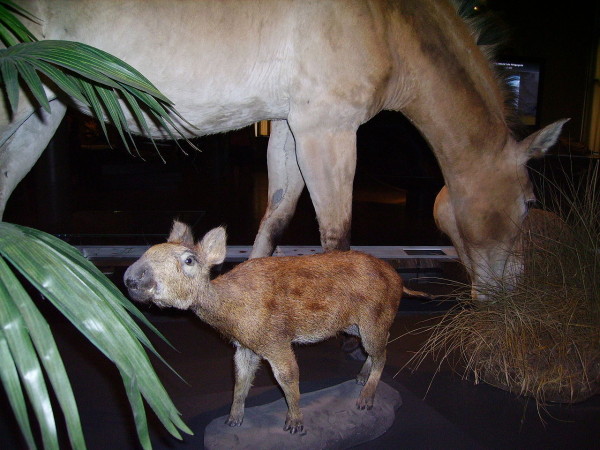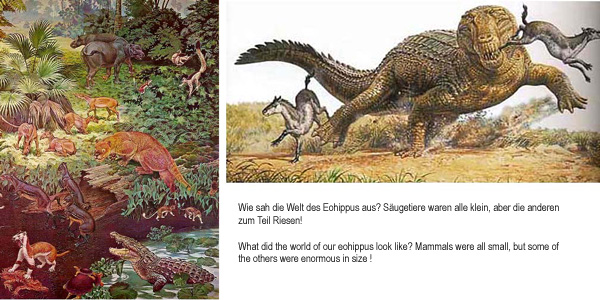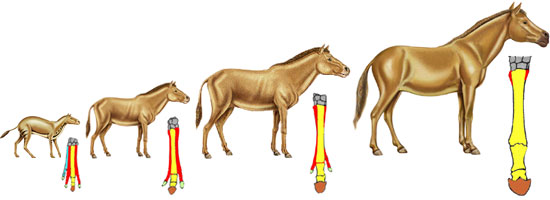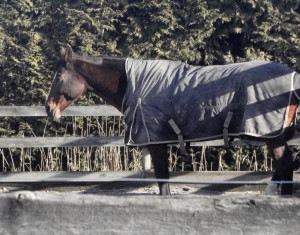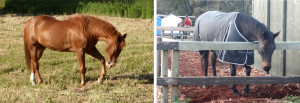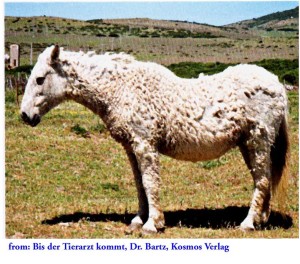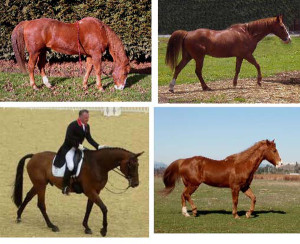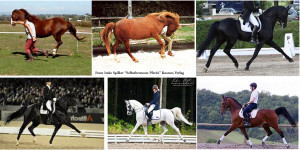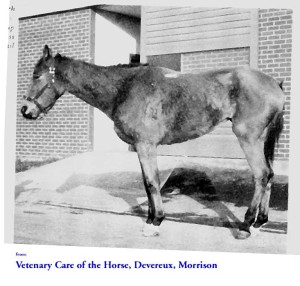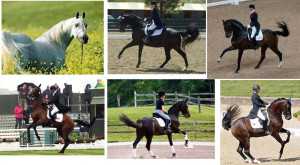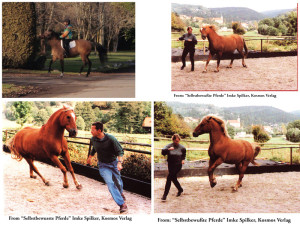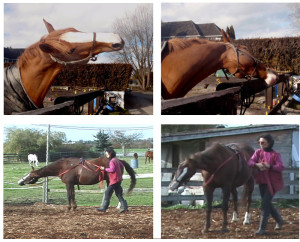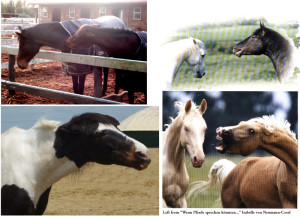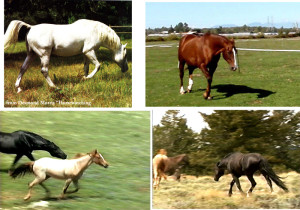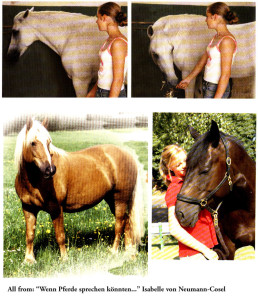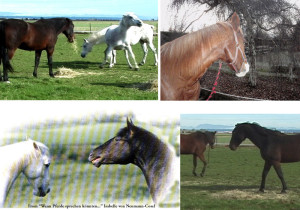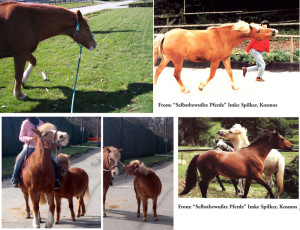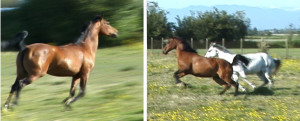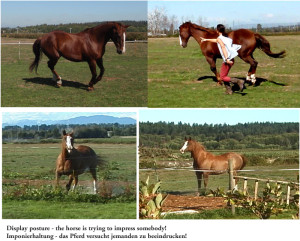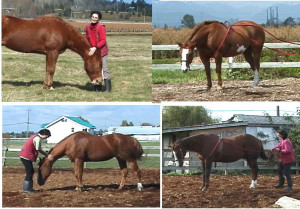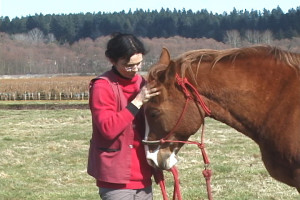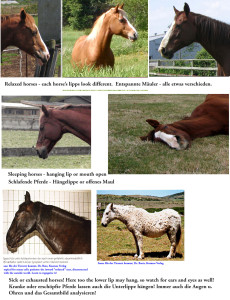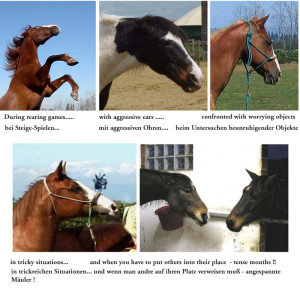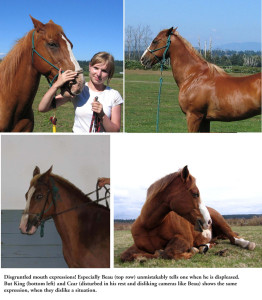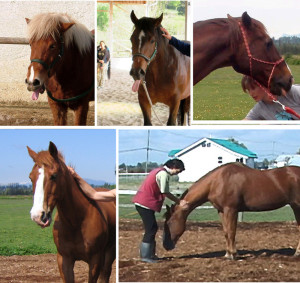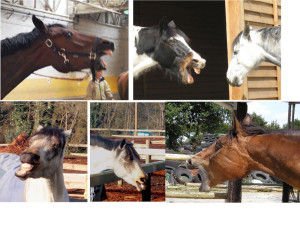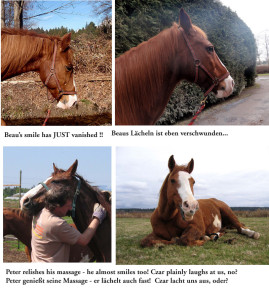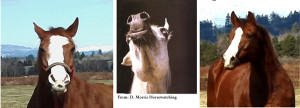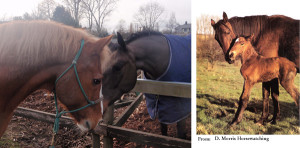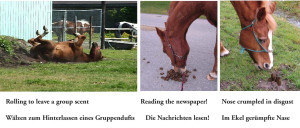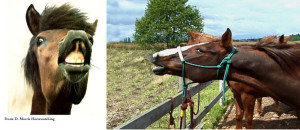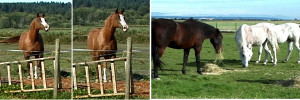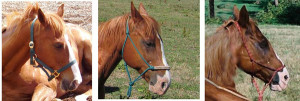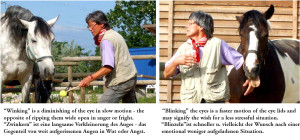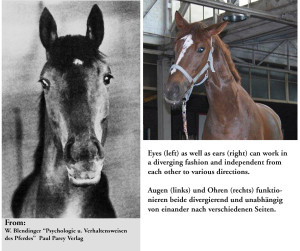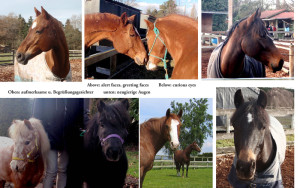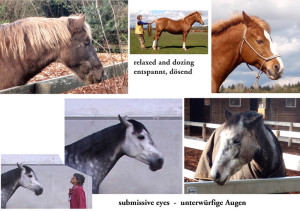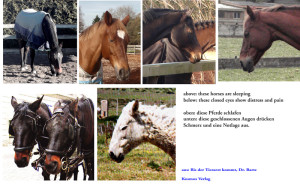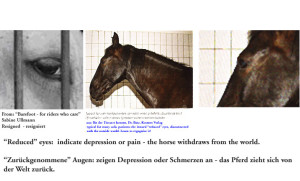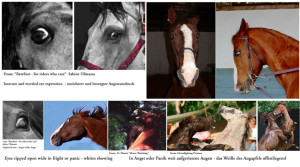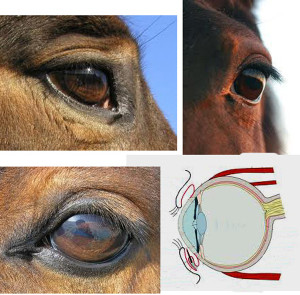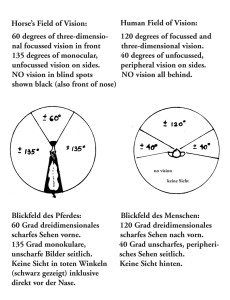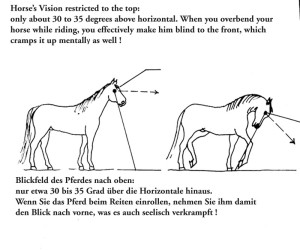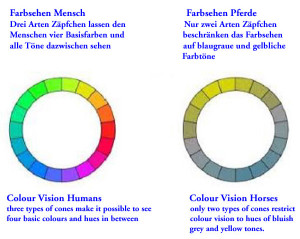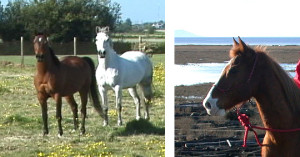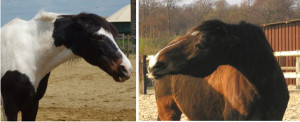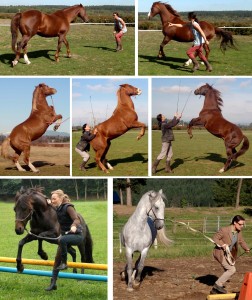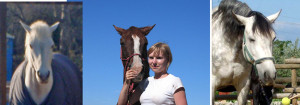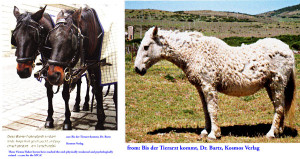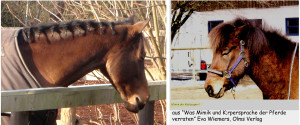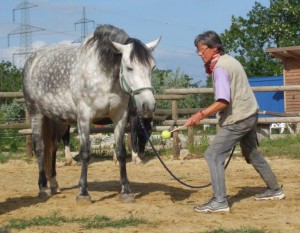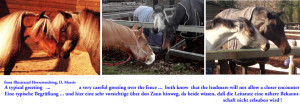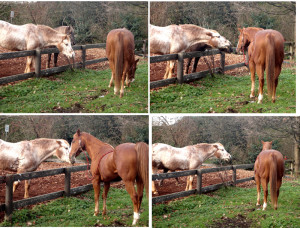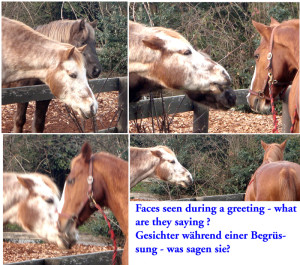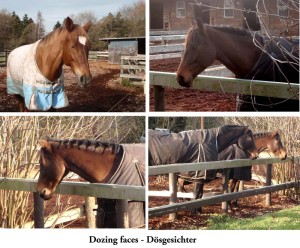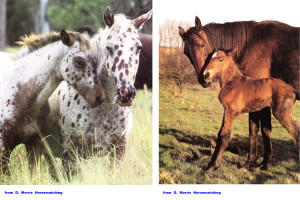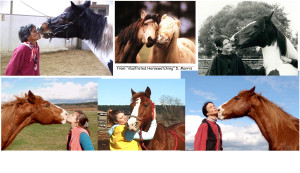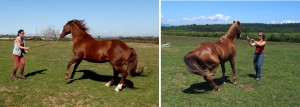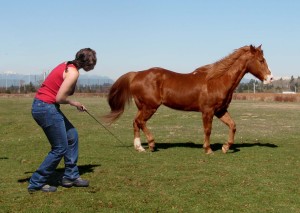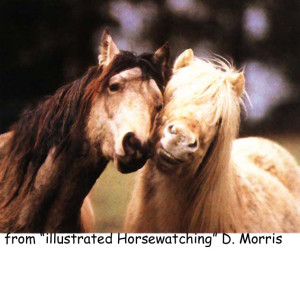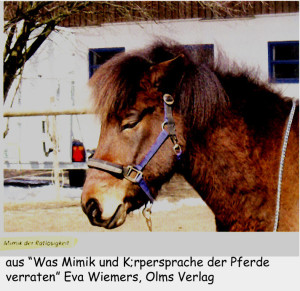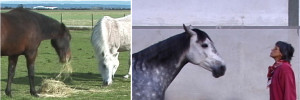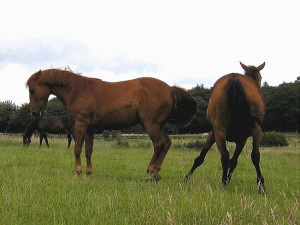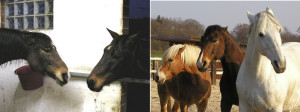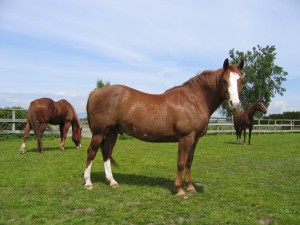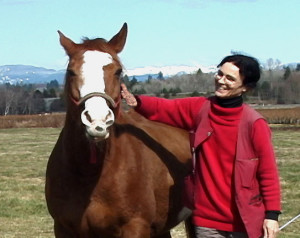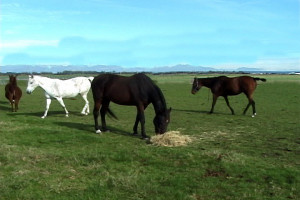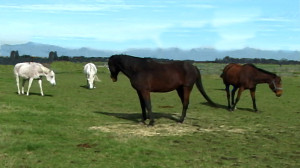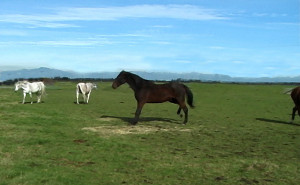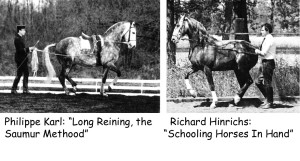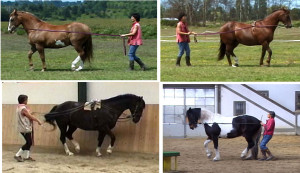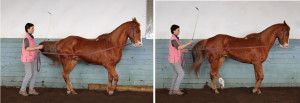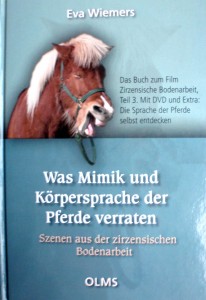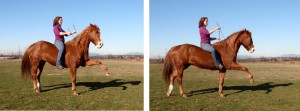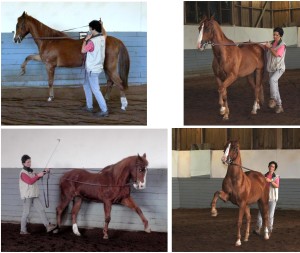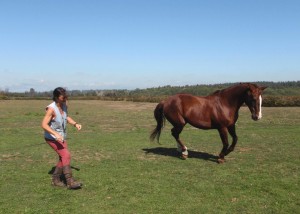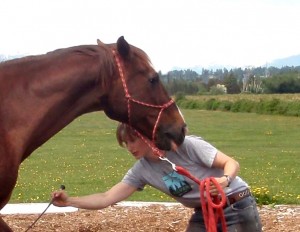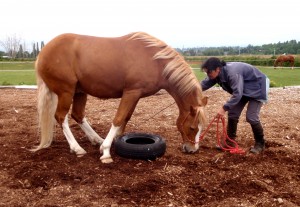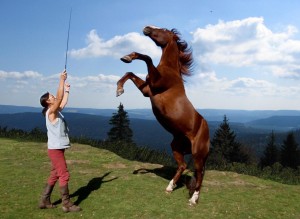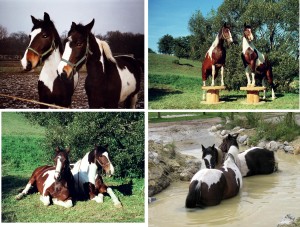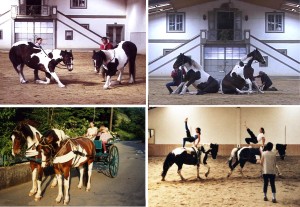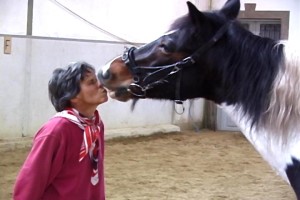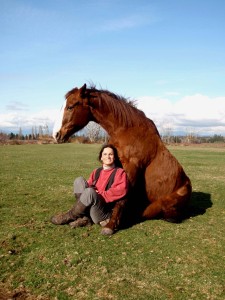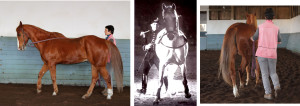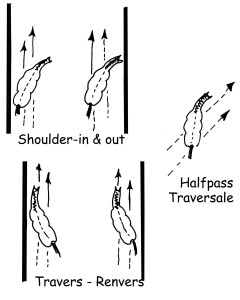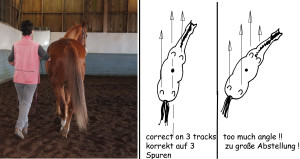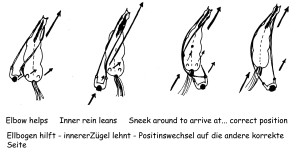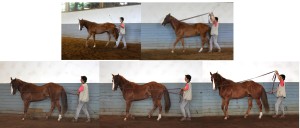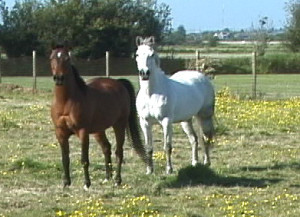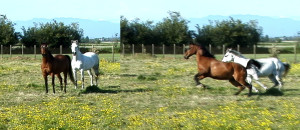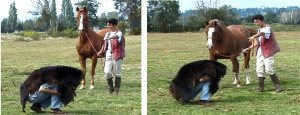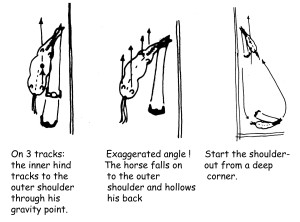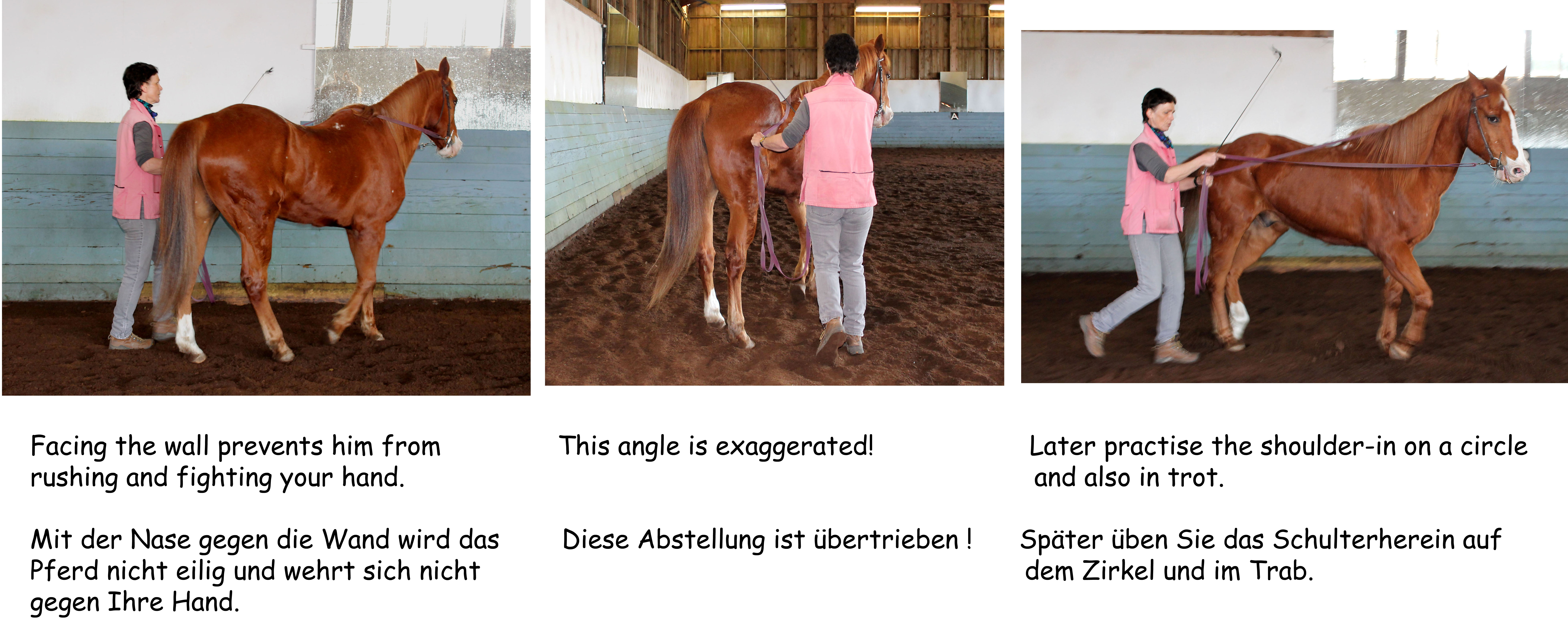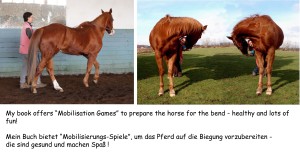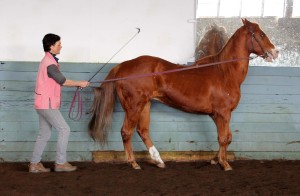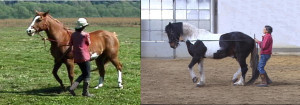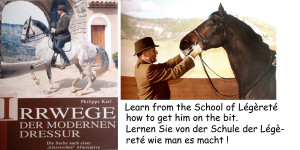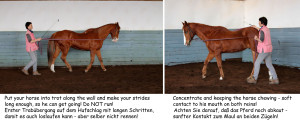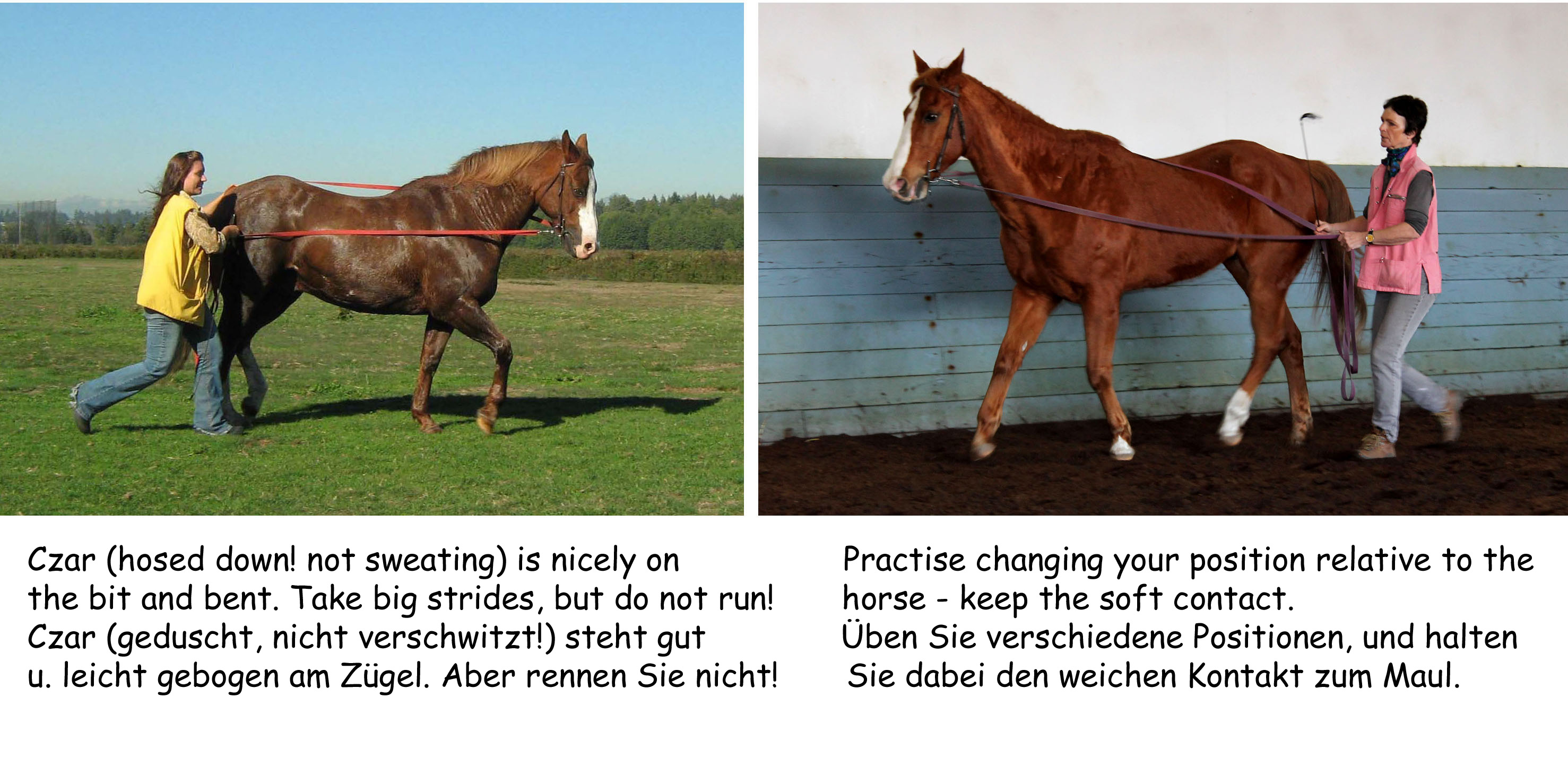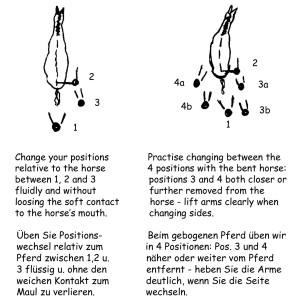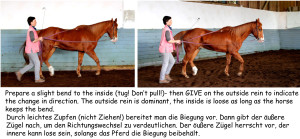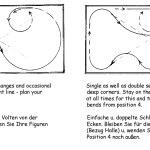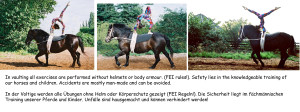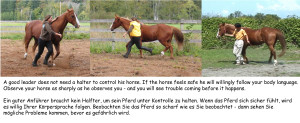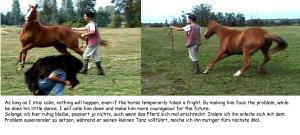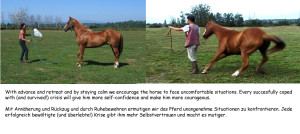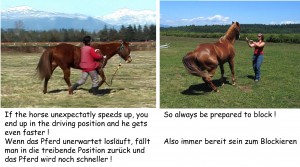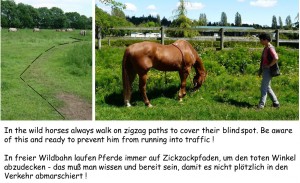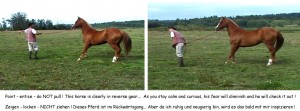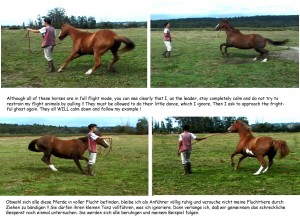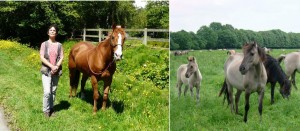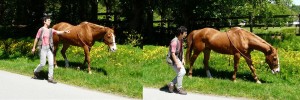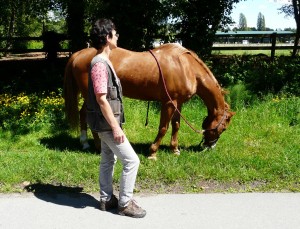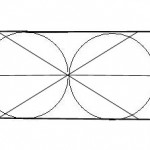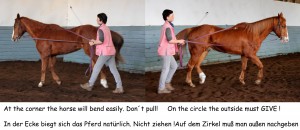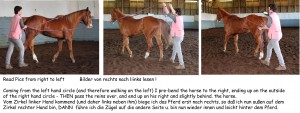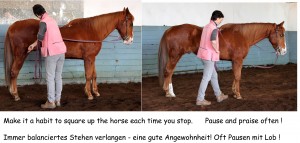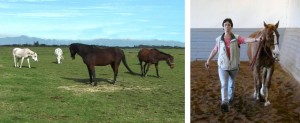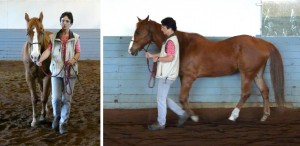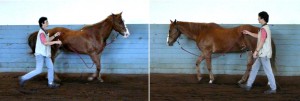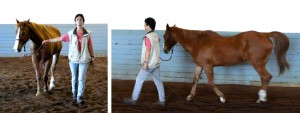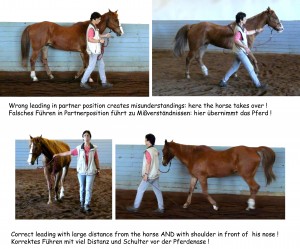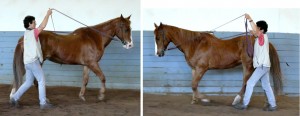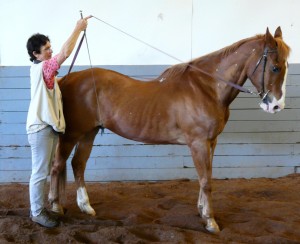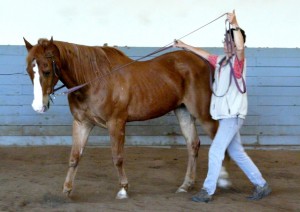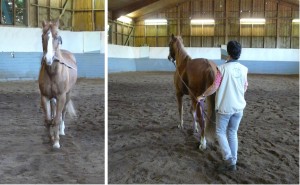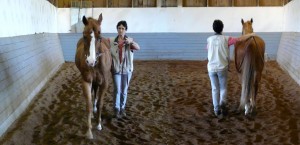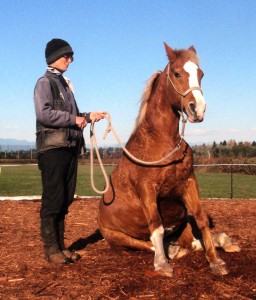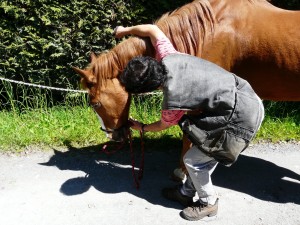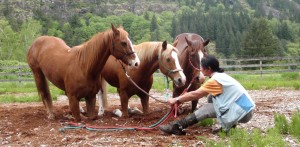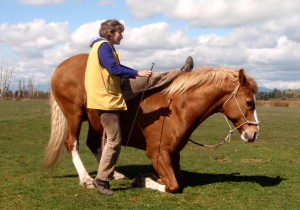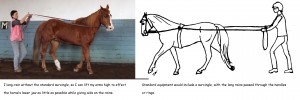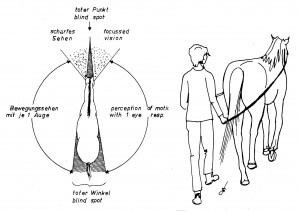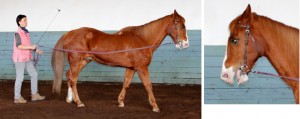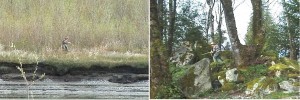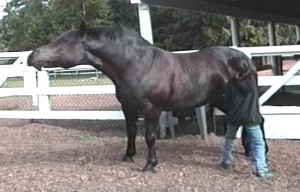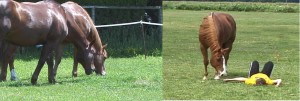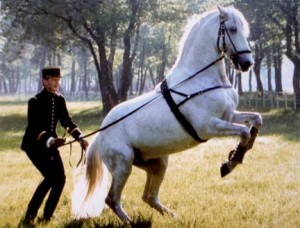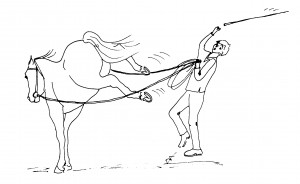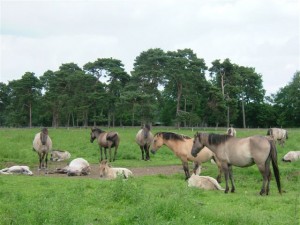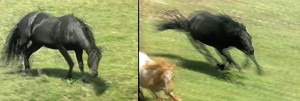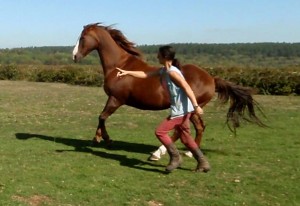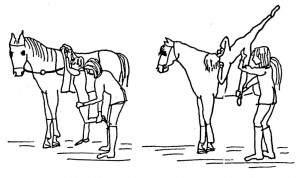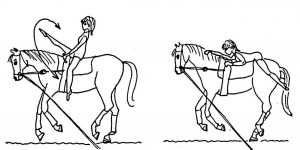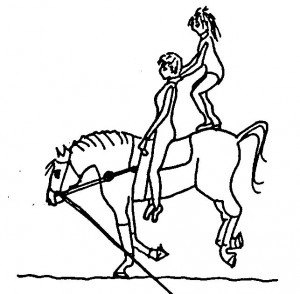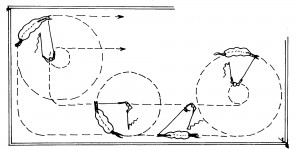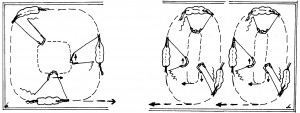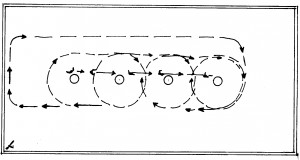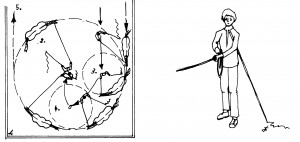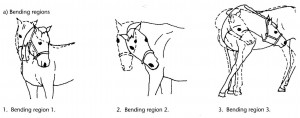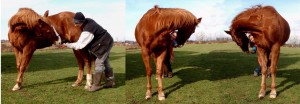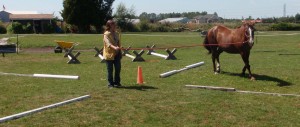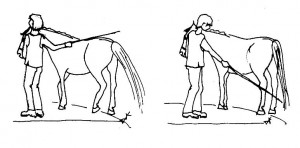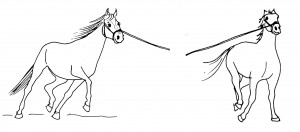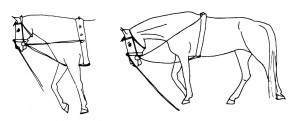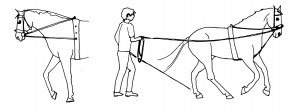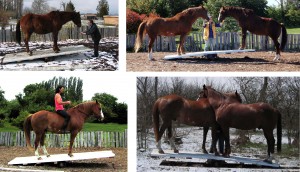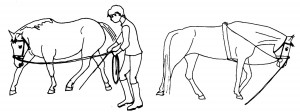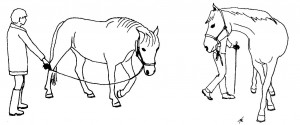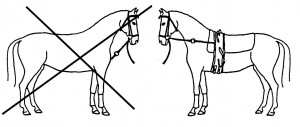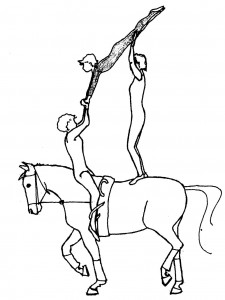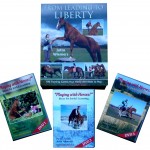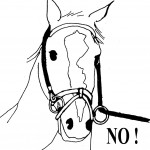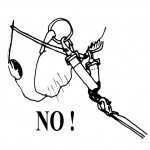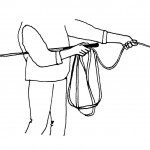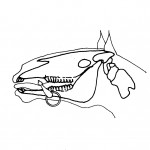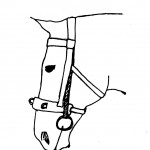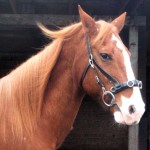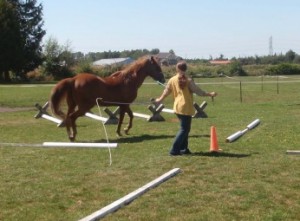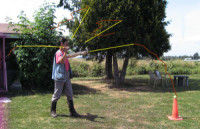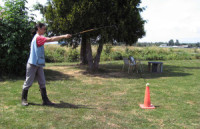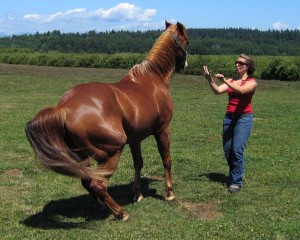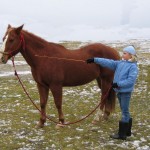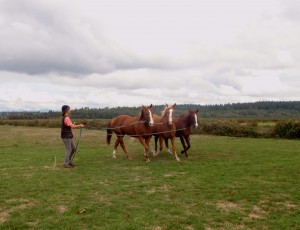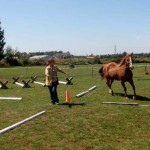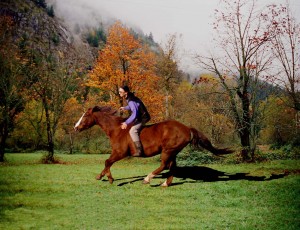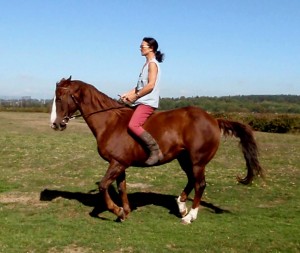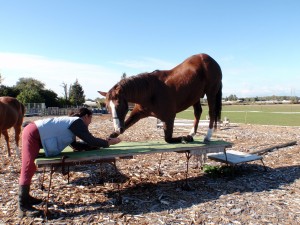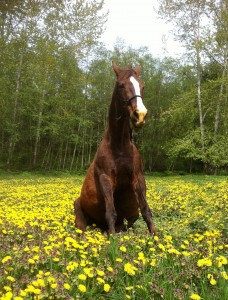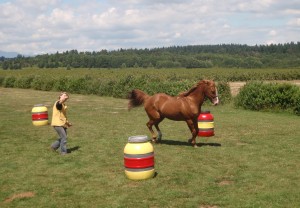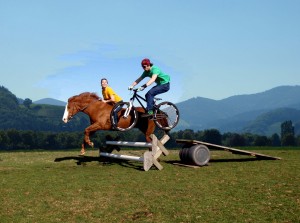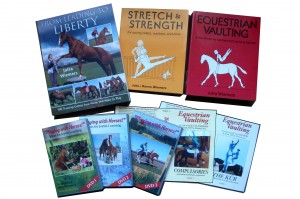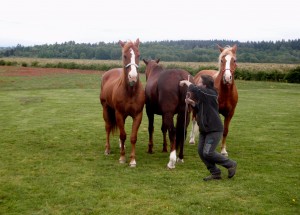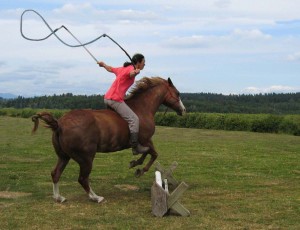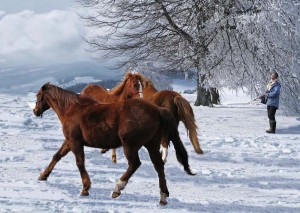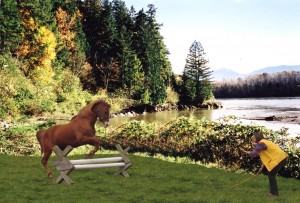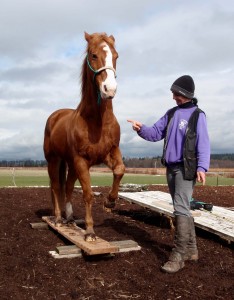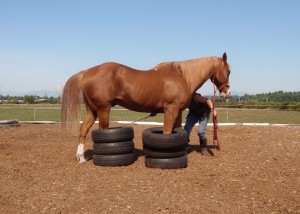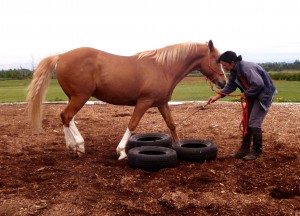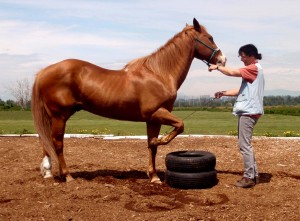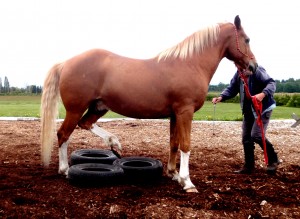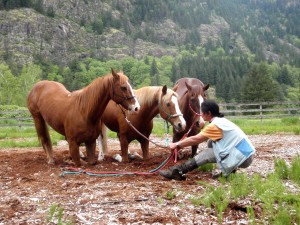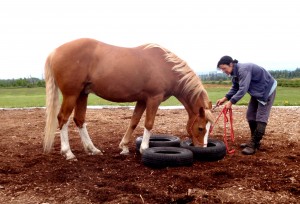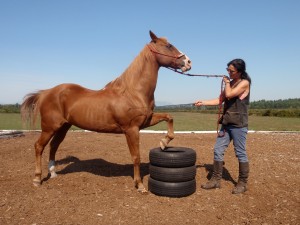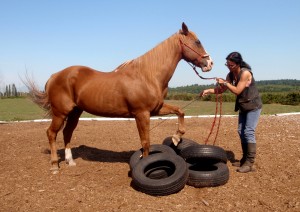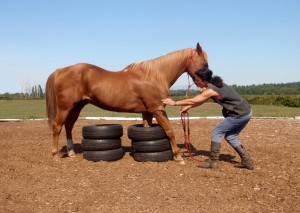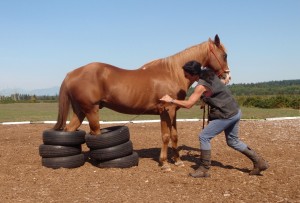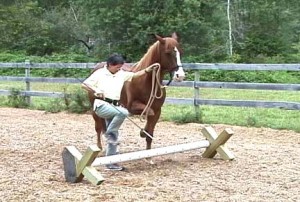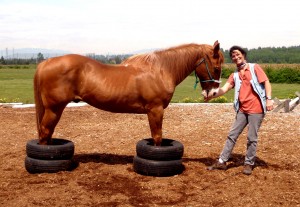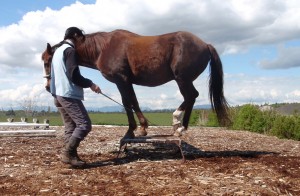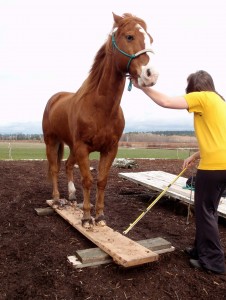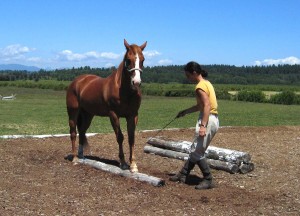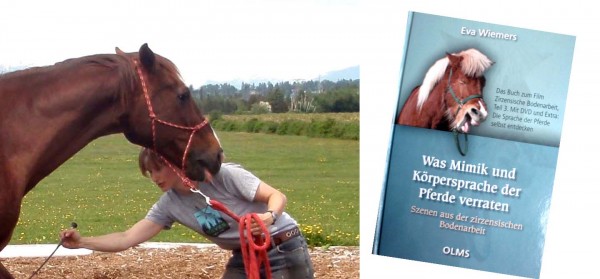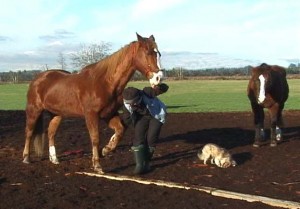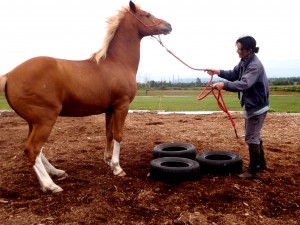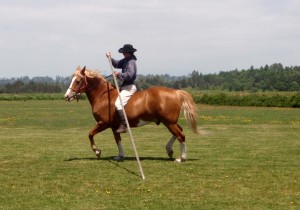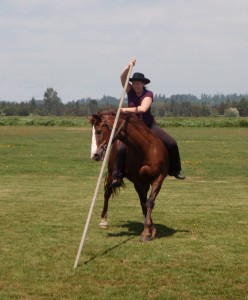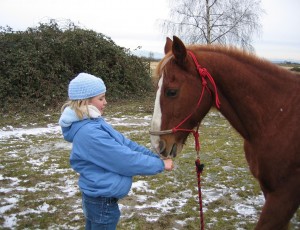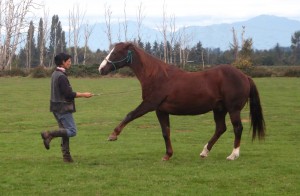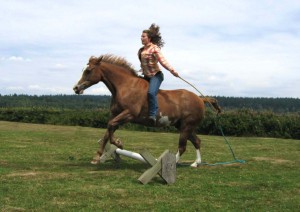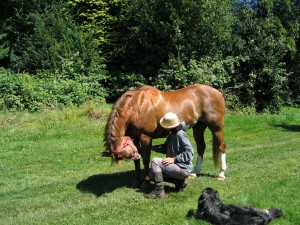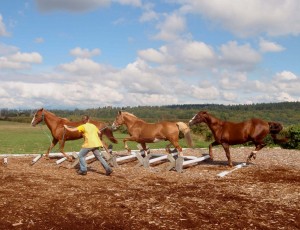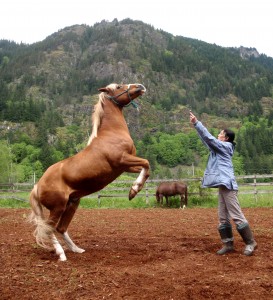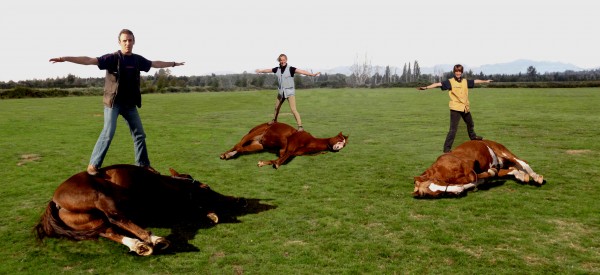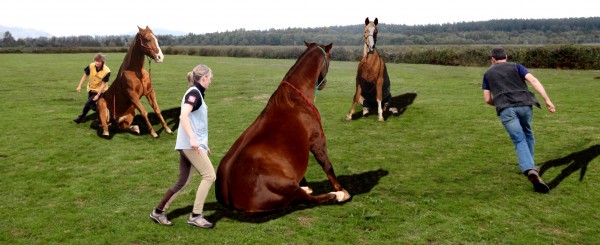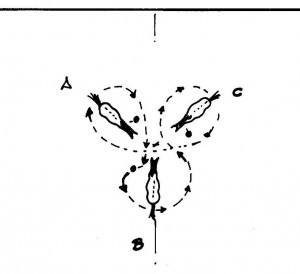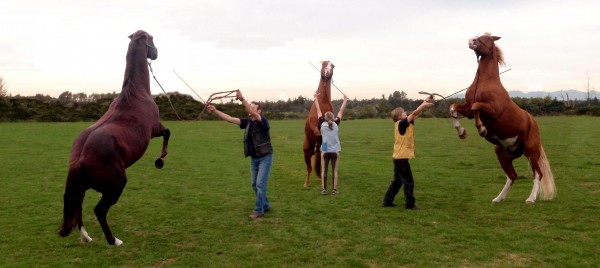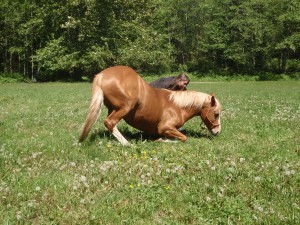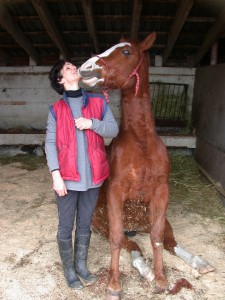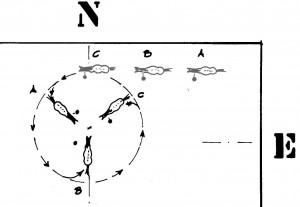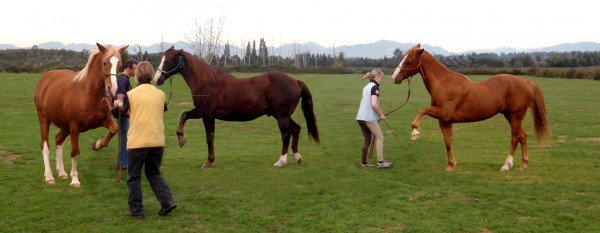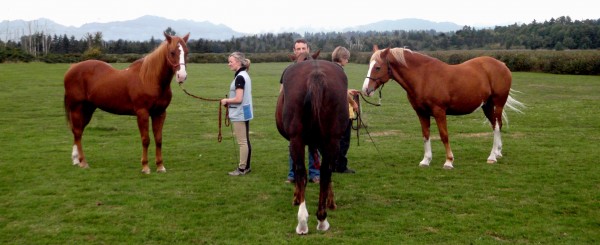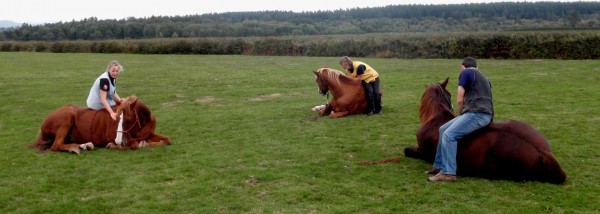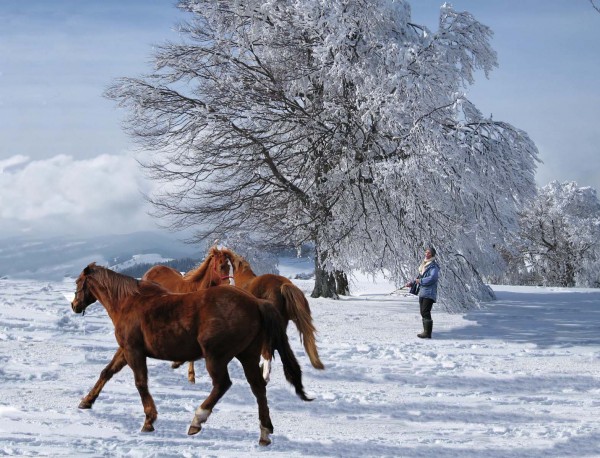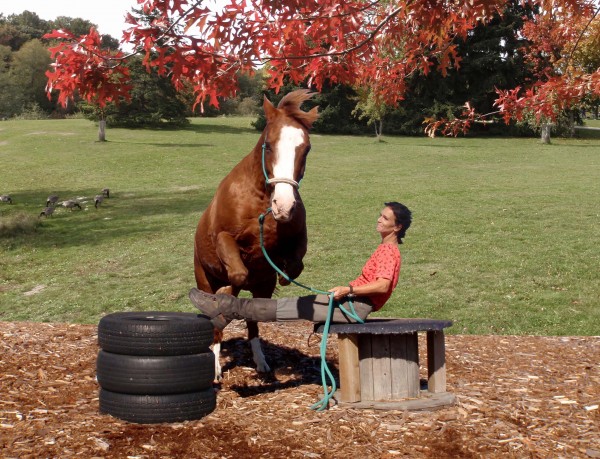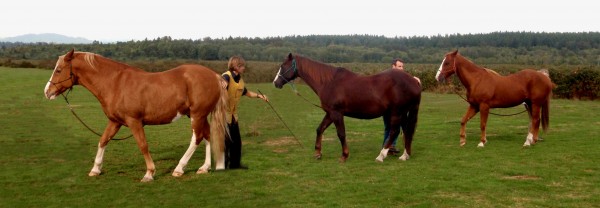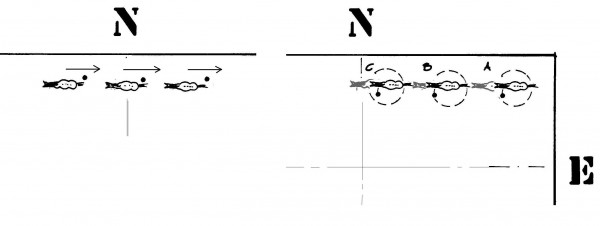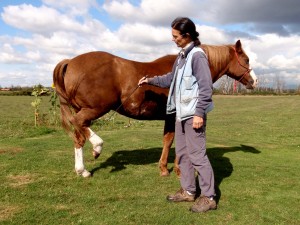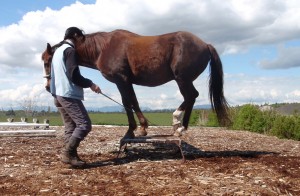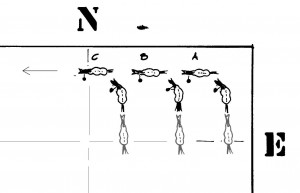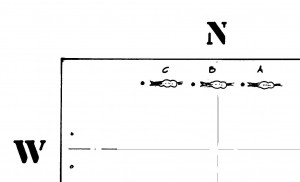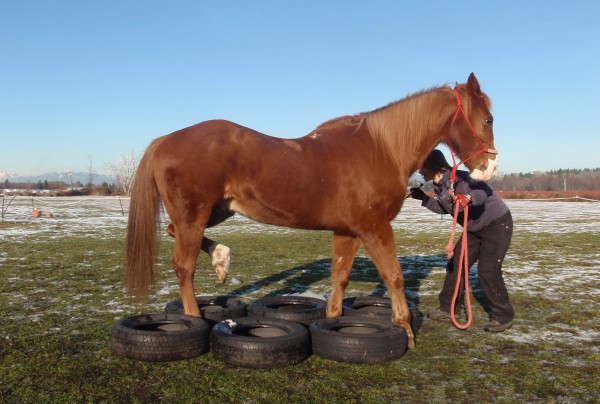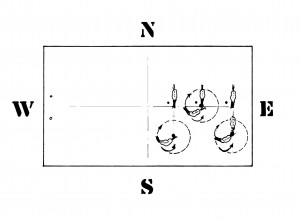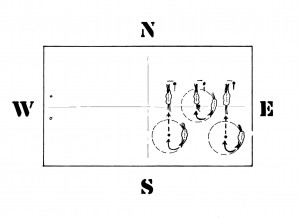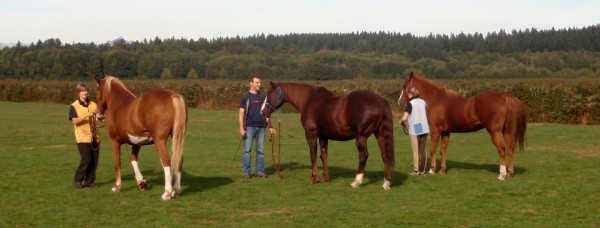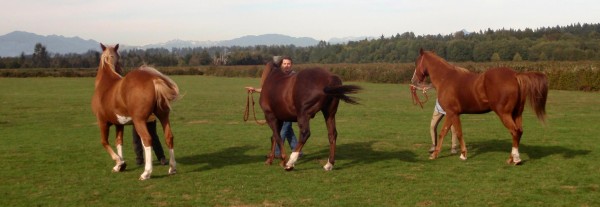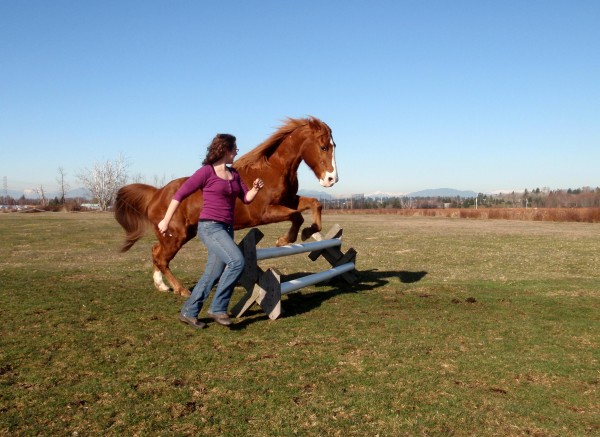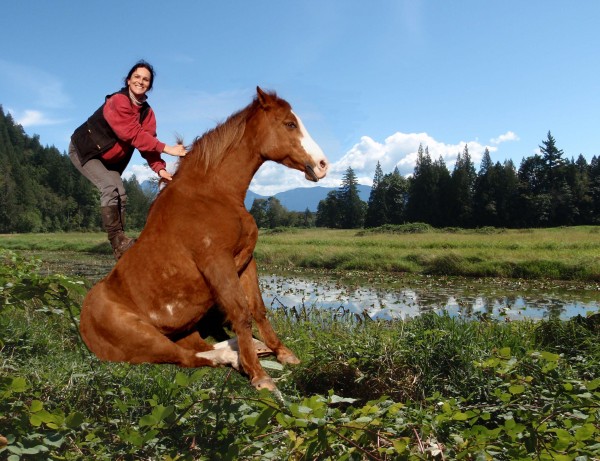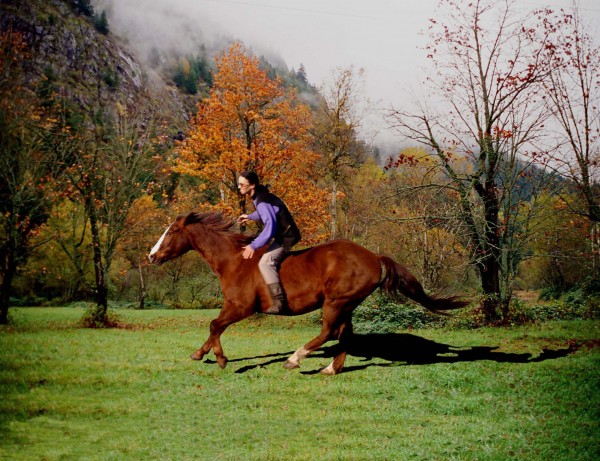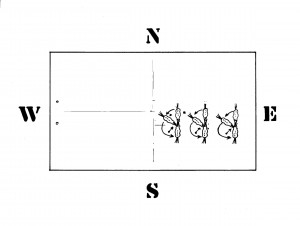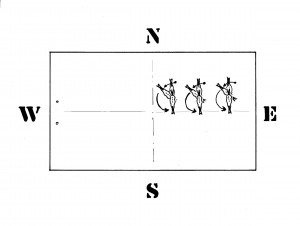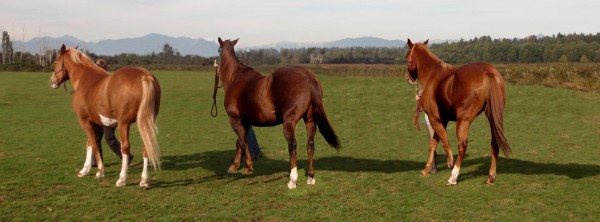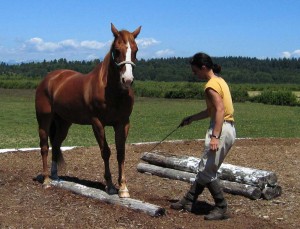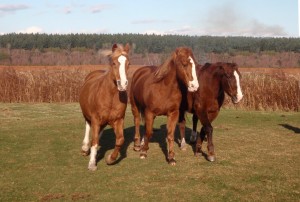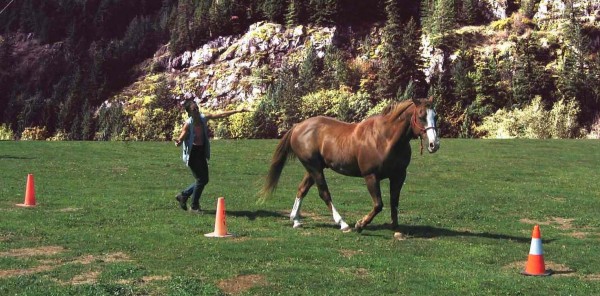History of the Horse – The Eocene era – Part 2 |
Die Geschichte des Pferdes – Das Eozän – Teil 2 |
|
A strong rise in temperature occurred!
|
Ein starker Temperaturanstieg geschah!
|
|
Suddenly more oxygen in the air!
Now new species evolved!
|
Es gab plötzlich mehr Sauerstoff !
So entstanden neue Tierarten !
|
|
|
|
|
|
|
|
| More about the development of the first horses in the next Blog – read on !! | Mehr über die Entwicklung der Urpferde im nächsten Blog – lesen Sie weiter !! | |
Blog of Smart Horses with Jutta Wiemers
History of the Horse – The Eocene era – Part 1 |
Die Geschichte des Pferdes – Das Eozän – Teil 1 |
|
The horse has been around much longer than we!
We owe what is known to geology!
We shall begin only in the Eocene era…
We start 56 million years ago:
|
Pferde gibts schon viel länger als uns!
Wir verdanken unser Wissen der Geologie!
Wir fangen erst im Eozän an…
Wir fangen vor 56 Millionen Jahren an:
|
|
In the eocene, i.e. about 56 Million years ago, begins the development of horse-like species.
Join me in my travel into the past –Read on !!
|
Im Eozän, also etwa vor 56 Mio Jahren beginnt die Entwicklung pferdeähnlicher Arten.
Kommen Sie mit auf die Reise in die Vergangenheit –Lesen Sie weiter! |
|
Understand your Horse – Part 23 |
Ihr Pferd verstehen – Teil 23 |
|
Sounds 2
4) The Snort:
5) The Blow:
6) The Squeal:
7) The roar, the scream:
8) Snore:
9) Grunt:
10) Groan:
11) Sigh:
This concludes my series of “Understanding your Horse”. I hope that reading about all the various signals, which your horse might send to you with his body language to communicate his feelings to you – his best friend and partner – has sharpened your eyes to his needs and deepened your interest in the life of an animal, which is so dependent on your good intentions – and, to have positive repercussions those must be knowledgeable!! |
Sounds 2
4) Trompeten:
5) Prusten und Schnauben:
6) Quietschen:
7) Schrei:
8) Schnarchen:
9) Grunzen:
10) Stöhnen:
11) Der Seufzer:
Hiermit schließe ich meine Serie „Ihr Pferd verstehen“ ab. Ich hoffe, daß das Lesen über all die Signale, die Ihr Pferd mit Körpersprache an Sie, seinen besten Freund und Partner, sendet, um Ihnen seine Gefühle mitzuteilen, Ihnen die Augen für seine Bedürfnisse geschärft und Ihr Interesse an dem Leben dieses Tieres, welches ja so auf Ihre guten Absichten angewiesen ist, vertieft hat – und die, um wirksam zu sein, eben auf richtiger Kenntnis basieren sollten!!
|
Understand your Horse – Part 22 |
Ihr Pferd verstehen – Teil 22 |
|
SOUNDS
How we use sounds:
Sounds a horse can make:
1) “Bubbling”:
2) Nicker:a) Greeting nicker:
b) Mare to foal:
c) Courtship nicker:
3) The Neigh:
We continue in the next Blog with more sounds! Read on !!!
|
LAUTE
Wie wir Laute benutzen:
Die Laute des Pferdes:
1) Blubbern:
2) Leises Wiehern:a) Zur Begrüßung:
b) Stute zu Fohlen:
c) Brummeln eines Freiers:
3) Lautes Wiehern:
Wir machen weiter im nächsten Blog mit mehr Lautgebungen! Lesen Sie weiter!! |
Understand your Horse – Part 21 |
Ihr Pferd verstehen – Teil 21 |
|
The Legs
1) Back leg lift:
|
Die Beine
1) Hinterbein anheben:
|
|
|
|
|
2) Front leg lift:
|
2) Anheben des Vorderbeins:
|
|
3) Pawing the ground:
|
3) Scharren:
|
|
4) Stamping:
5) Knocking:
In the next Blog we will listen… though most of the horse’s feelings will be expressed by body language, horses ARE able to communicate by sounds as well! Read on!! |
4) Stampfen:
5) Klopfen:
Im nächsten Blog hören wir zu … denn obwohl Pferde die meisten ihrer Gefühle durch Körpersprache ausdrücken, sind sie dennoch auch fähig sich mit Lauten mitzuteilen! Lesen Sie weiter!! |
|
Understand your Horse – Part 20 |
Ihr Pferd verstehen – Teil 20 |
|
The Tail
1) Drooped tail:
|
Der Schweif
1) Hängender Schweif:
|
|
But note:
|
Aber Achtung:
|
|
2) Carried tail:
|
2) Getragener Schweif:
|
|
|
|
|
3) High Tail: also flicking
|
3) Hochgereckter, auch schnippender Schweif:
|
|
|
|
|
4) Pinched tail:
|
4) Eingeklemmter Schweif:
|
|
5) Stiff rod:
6) Swishing tail:
|
5) Steife Schweifrübe:
6) Peitschender Schweif:
|
|
7) Twisting Tail:
8) Slapping the tail hard:
Read on!!! |
7) Schweif-Zwirbeln:
8) Den Schweif hart schlagen:
Lesen Sie weiter!! |
|
Understand your Horse – Part 19 |
Ihr Pferd verstehen – Teil 19 |
|
Neck 3
11) Head wobble:
|
Hals 3
11) Kopf wackeln: Hals schwenken
|
|
12) Neck wringing:
|
12) Hals verwinden: in Spirale
|
|
13) Horizontally extended neck:
|
13) Kopf horizontal ausgestreckt:
|
|
14) Head snaking:
|
14) Kopf Schlängeln:
|
|
Neurotic Neck movements:
|
Neurotische Halsbewegungen:
|
|
15) Head circling:
16) Weaving:
In the next Blog let’s turn to the tail, which a horse can of course also use for communication! Read on !! |
15) Kopf Kreiseln:
16) Weben:
Wenden wir uns im nächsten Blog dem Schweif zu, mit dem ein Pferd sich ja auch verständigen kann! Lesen Sie weiter !! |
|
Understand your Horse – Blog 18 |
Ihr Pferd verstehen – Teil 18 |
|
Neck 2
6) Head turning toward you:
|
Hals 2
6) Kopf zum Menschen hin drehen:
|
|
7) Head swing away from:
|
7) Kopf weg drehen:
|
|
8) Head bobbing:
9) Chin thrust:
|
8) Kopf Auf-und-Abtauchen:
9) Kopf Stoßen:
|
|
10) Head jerk:
But horses can express much more with their Head and neck movements! In the next Blog we continue with head wobbling… Read on !! |
10) Kopf Rucken:
Aber Pferde können noch viel mehr mit Kopf und Hals Bewegungen ausdrücken! Im nächsten Blog geht es weiter mit Kopf-Wackeln… Lesen Sie weiter !! |
|
Understand your Horse – Part 17 |
Ihr Pferd verstehen – Teil 17 |
|
Neck & Head 1
1) High head position: concave top line
|
Hals & Kopf 1
1) Hohe Kopfhaltung: konkave Oberlinie
|
|
2) High head position: convex top lineDisplay behaviour
|
2) Hohe Kopf Position: konvexe OberlinieImponiergehabe
|
|
As we are discussing movements in the following points, there will be fewer pictures. I hope the descriptions are clear enough. 3) Head toss:
4) Head and neck shake:
|
Da wir hier in den folgenden Punkten hauptsächlich Bewegungen ansprechen, gibt es weniger Bilder. Ich hoffe die Beschreibungen sind klar genug. 3) Kopf hoch werfen:
4) Kopf und Hals schütteln:
|
|
5) Low head and neck posture:
In the next Blog we continue with Head and Neck posturesRead on !!! |
5) Tiefe Kopf und Hals Haltung:
Im nächsten Blog geht es weiter mit Kopf und Hals Haltungen.Lesen Sie weiter !!! |
|
Understand your Horse – Part 16 |
Ihr Pferd verstehen – Teil 16 |
|
The Mouth 2
7) Mouth neutral and relaxed:
|
Maul 2
7) Maul neutral und entspannt:
|
|
8) Jaws held tensely open with fully exposed teeth:
|
8) Weit offenes Maul mit gebleckten Zähnen:
|
|
9) Tight lipped mouth:
|
9) Angespannte Maulpartie:
|
|
|
|
|
10) Disgruntled mouth:
|
10) Mißmutiges Maul:
|
|
11) Chewing, licking and showing the tongue:
|
11) Kauen, Lecken und Zunge zeigen:
|
|
12) Yawning:
|
12) Gähnen:
|
|
13) Licking as sign of tenderness:
|
13) Lecken – Ausdruck von Zärtlichkeit:
|
|
14) A smile!
Let’s move on to the horse’s neck in the following Blog! Read on !!! |
14) Ein Lächeln!
Weiter gehts mit dem Hals des Pferdes im nächsten Blog! Lesen Sie weiter !! |
|
Understand your Horse – Part 15 |
Ihr Pferd verstehen – Teil 15 |
|
Mouth 1
1) The function:
|
Maul 1
1) Die Funktion:
|
|
2) Food intake:
3) Sense of taste:
|
2) Nahrungsaufnahme:
3) Schmecken:
|
|
4) The lips:
5) The tactile hairs:
Now to the first “expression” with the mouth. |
4) Die Lippen:
5) Tasthaare:
Nun zum ersten „Ausdruck“ mit dem Maul. |
|
6) Foal snapping:
We continue in the next blog with more expressions of the horse’s mouth.
Read on !!! |
6) Leer kauen:
Im nächsten Blog geht es weiter mit dem, was das Pferd mit dem Maul ausdrücken kann.
Lesen Sie weiter !!! |
|
Understand your Horse – Blog 14 |
Ihr Pferd verstehen – Teil 14 |
|
Nose
1) The nose: the function
|
Die Nase
1) Die Nase: Funktion
|
|
2) Evolution:
3) Survival:
4) Emotions:
|
2) Evolution:
3) Überleben:
4) Emotionen:
|
|
5) Leaving a group scent:
6) Reading the news:
|
5) Einen Gruppenduft hinterlassen:
6) Nachrichten lesen:
|
|
7) Being disgusted:
8) Nostrils flared:
9) Flehmen:
|
7) Ekelhaft!
8) Geblähte Nüstern:
9) Flehmen:
|
|
10) Itchy nose! Substitute activity
|
10) Juckende Nase! Übersprunghandlung
|
|
11) Happy crinkle nose:
Next time we look at the horse’s mouth. Read on!!
|
11) Glückliche Kräuselnase:
Nächstes Mal sehen wir uns das Pferdemaul an. Lesen Sie weiter!! |
|
Understand your Horse – Part 13 |
Ihr Pferd verstehen – Teil 13 |
|
Eyes 3
10. Frontal stare:
|
Augen 3
10. Frontales Anstarren:
|
|
11. Worry lines around the eyes:
|
11. Sorgenfalten um die Augen:
|
|
12. Dark rings:
|
|
|
13. Your horse may wink at you!
|
13. Ihr Pferd zwinkert Sie an!
|
|
14. Blinking the eyes:
Summary eyes:
|
14. Blinzeln:
Zusammenfassung Augen:
|
|
We move on to other parts of the horse to understand his emotions! Read on !! |
Wir sehen uns demnächst weitere Körperteile des Pferdes an, um seine Gefühle zu verstehen! Lesen Sie weiter!! |
|
Understand your Horse – Part 12 |
Ihr Pferd verstehen – Teil 12 |
|
Eyes 2
1. Attentive eyes, bifocal, focussed and three dimensional vision:
|
Augen 2
1. Aufmerksame Augen, bifokal, scharfes und drei dimensionales Sehen:
|
|
2. Curious eyes¸ interested eyes:
3. Half closed: a) peaceful relaxation, or dozing
|
2. Neugierige, interessierte Augen:
3. Halb geschlossen: a) friedlich entspannt oder dösend
|
|
4. Half closed: b) submission, appeasement
5. closed eyes: a) sleepingWhen the horse is truly sleeping, the eyes are completely closed. The deeper the sleep (and the greater the trust in peaceful and safe surroundings) the lower the ears and the head may droop at the same time. On the left you see Deena, who sleeps so deeply that she nearly topples over. The lower lip is always relaxed and often hanging down in quite a pronounced manner. |
4. Halb geschlossen: Unterwürfig, beschwichtigend
5. Geschlossene Augen: a) Schlaf
|
|
6. Closed eyes: b) exhaustion or pain
|
6. Geschlossenen Augen: b) Schmerz oder Erschöpfung
7. „Zurückgenommener Blick“: deprimiert, resigniert
|
|
8. Showing some white: worried eyes
|
8. Ein bißchen weiß: besorgte Augen
|
|
9. Wide eyes: fear, panic, flight or real anger
In the next Blog we will finish with the expression of the eyesRead on !! |
9. Weit aufgerissen: Angst, Panik, Flucht oder echte Wut
Im nächsten Blog schließen wir mit den Augen ab.Lesen Sie weiter!! |
|
Understand your Horse – Part 11 |
Ihr Pferd verstehen – Teil 11 |
|
Eyes 1
|
Augen 1
|
|
The main difference between our outlooks on the world:
Retina with Rods and cones:
Field of vision:
|
Der Hauptunterschied unserer „Welt-Anschauungen“:
Retina mit Stäbchen und Zäpfchen:
Gesichtsfeld:
|
|
The “spooky side”:
Field of vision to the top:
|
Die „Scheu“ seite:
Blickfeld nach oben:
|
|
Colour vision:
|
Farbsehen:
|
|
|
|
|
This is the world your horse sees! Next time we go into what the horse communicates to us with his eyes!
Read on !! |
So also sieht Ihr Pferd! Nächstes Mal schauen wir, was es uns mit den Augen sagen kann.
Lesen Sie weiter !! |
|
Understand your Horse – Part 10 |
Ihr Pferd verstehen – Teil 10 |
|
continued – Ears 4
|
Fortsetzung – Ohren 4
|
|
Questioning – happy or apprehensive?
9. Disapproving Ears:
|
Fragend – zufrieden oder ängstlich besorgt?
9. Mißmutige Ohren:
|
|
10. Aggressive Ears: pinned
|
10. Aggressive Ohren: angepreßt
|
|
|
|
|
11. Play Ears:
|
11. Spiel-Ohren:
|
|
Conclusion Ears:Do not always assume aggression !!
We learned:
In the next Blogs we will look at the horses eyes – how he sees the world and what he is trying to signal to us with them. Read on !!
|
Zusammenfassung Ohren:Nicht immer Aggression vermuten!
Wir haben gelernt:
Im nächsten Blog wollen wir die Augen des Pferdes erforschen – wie es die Welt sieht und was es versucht, uns mit ihnen zu sagen.
Lesen Sie weiter !! |
|
Understand your Horse – Part 09 |
Ihr Pferd verstehen – Teil 09 |
|
continued: Ears 3
|
Fortsetzung Ohren 03
|
|
5/6: Questioning and helpless:
|
5/6: Fragend und ratlos:
|
|
Airplane Ears – what do they mean:pain, distress, submissiveness, or appeasement ?? 7. Depressed Ears:
|
Flügelohren – was sie bedeuten :Schmerz, Kummer, Unterwürfigkeit, oder Beschwichtigung ?? 7. Deprimierte Ohren:
|
|
8. Appeasing Ears:
|
8. Beschwichtigende Ohren:
|
|
|
|
|
In the next part we will finish with the contemplation of the ears’ language. Read on !!
|
Im nächsten Teil schließen wir mit der Sprache der Ohren ab. Lesen Sie weiter!! |
|
Understand your Horse – Part 08Ears instalment 2 |
Ihr Pferd verstehen – Teil 08Fortsetzung Ohren 2 |
|
4. Sleepy Ears:
|
4. Schlafohren:
|
|
5. Helpless ears, at a loss:
|
5. Ratlose Ohren:
|
|
|
|
|
6. Questioning Ears:
|
6. Fragende Ohren:
|
|
|
|
|
In the next Blog we will continue with more interesting ears expressions!!Read on !! |
Im nächsten Blog kommen noch mehr interessante Ohren!Lesen Sie weiter !! |
|
Understand your Horse – Part 06 |
Ihr Pferd verstehen – Teil 06 |
|
4. The grooming face:
|
4. Putzgesichter:
|
|
5. The greeting face:
|
5. Ein Begrüßungsgesicht:
|
|
|
|
|
|
|
|
|
|
|
This is what we shall attempt to clarify in the coming Blogs and will turn to the language of the ears!
Read on !! |
In den nächsten Blogs versuchen wir das zu erklären und wenden uns der Sprache der Ohren zu!
Lesen Sie weiter!! |
|
Understand your Horse – Part 04 |
Ihr Pferd verstehen – Teil 04 |
|
3) Standing or moving parallel to or with a partner:
|
3) Sich mit einem Partner parallel stellen oder bewegen:
|
|
4) The body check or body block:
|
4) Die Körpersperre:
|
|
5) The shoulder barge:
6) The rump presentation:
|
5) Schulter rempeln:
6) Das Hinterteil präsentieren:
|
|
More to come – read on !!! |
Es kommt noch mehr – lesen Sie weiter !!! |
|
Understand your Horse – Part 03 |
Ihr Pferd verstehen – Teil 03 |
|
Function versus emotion:
The function always overrides the display of an emotion!!
Functions:
Emotions shown by horses:
You need to educate your eyes:
Expression with the whole body:
1) Coming toward you:
|
Funktion versus Gefühle:
Die Funktion hat immer den Vorrang vor dem Ausdruck eines Gefühls!!
Funktion:
Gefühle, die ein Pferd zeigt:
Sie müssen Ihre Augen schulen:
Ausdruck mit dem ganzen Körper:
1) Auf jemanden zukommen:
|
|
1) Turning away from you:
|
1) Sich wegdrehen:
|
|
In the next Blog we will continue with more “vocabulary”, what the horse expresses with the whole body – read on !! |
Im nächsten Blog fahren wir mit dem „Vokabular“ , was das Pferd mit dem ganzen Körper ausdrückt, fort – lesen Sie weiter! |
|
Happy Holidays!Speaking on my own behalf |
Fröhliche Feiertage!In eigener Sache |
|
|
|
|
Long-reining – Part 12 |
Arbeit am langen Zügel – Teil 12 |
|
The piaffe:
|
Die Piaffe:
|
|
Very useful prep-Games:
|
Sehr nützliche Vorbereitung:
|
|
Back-up and trot transitions:
|
Übergänge Rückwärtsrichten und Antraben:
|
|
|
|
|
Canter on the long-reins:
Synchronize well!
|
Galopp am langen Zügel:
Sychronisieren Sie sich!
|
|
Read on! |
Lesen Sie weiter! |
|
Long-reining – Part 11 |
Arbeit am langen Zügel – Teil 11 |
|
We needed cheering up!
The Spanish Step: a great motivator!
|
Wir brauchten Aufheiterung!
Er spanische Schritt ist eine tolle Motivation!
|
|
The Spanish Walk on the long-reins:
Teach it in small increments:
|
Der spanische Schritt am langen Zügel:
In kleine Lernschritte zerlegen:
|
|
|
|
|
|
|
|
The timing of aids is essential!
Pre-requisites fulfilled:
|
Das Timing der Hilfen ist wesentlich!
Alle Voraussetzungen erfüllt:
|
|
Give it a try! See if it doesn’t motivate your horse! Read on!! |
Versuchen Sie es! Sie werden sehen wie sehr es Ihr Pferd motiviert! Lesen Sie weiter!! |
|
Obituary on Johnny, October 2013 |
Nachruf auf Johnny, Oktober 2013 |
|
|
|
|
|
|
|
|
|
|
|
|
|
|
|
|
|
|
|
Long-Reining – Part 10 |
Arbeit am langen Zügel – Teil 10 |
|
The pirouette:
|
Pirouette:
|
|
|
|
|
|
|
|
The half-pass:
|
Die Traversale:
|
|
|
|
|
Half-pass in trot:
Read on in part 11 ! |
Traversale im Trab:
Lesen Sie weiter im nächsten Teil! |
|
Long-Reining – Part 07 |
Arbeit am langen Zügel – Teil 07 |
|
Learning to bend and step under:
The “Shoulder-out”:
|
Biegen und Untertreten:
Das „Schulter-Heraus“:
|
|
|
|
|
|
|
|
Shoulder-in:
|
Schulter-Herein:
|
|
Shoulder-in on the circle – balance:
|
Schulter-Herein auf dem Zirkel – Balance:
|
|
In the next part we will attempt the straight bend! Much more difficult for my horses to understand! Read on! |
Im nächsten Teil werden wir die Biegung auf der Geraden versuchen – für meine Pferde viel schwieriger zu verstehen! Lesen Sie weiter! |
|
Work on the long-reins – Part 04 |
Arbeit am langen Zügel – Teil 04 |
|
Lay your tracks down for orientation:
Attempt a circle:
Turning onto the circle line:
|
Legen Sie sich Spuren zur Orientierung:
Nun der Zirkel:
Abbiegen auf die Zirkellinie:
|
|
Possible problems:
Practise different positions:
|
Mögliche Probleme:
Üben der verschiedenen Positionen:
|
|
Figure Eights:
Possible problems:
|
Achter Figuren:
Mögliche Probleme:
|
|
|
|
|
Remember:
Last but not least: |
Beachten Sie:
Zu guter Letzt: |
|
Next time we will start to work in trot and practise more steering (serpentines, voltes and so on) |
Nächstes Mal fangen wir an im Trab zu arbeiten und üben weiter gut zu lenken (Schlangenlinien, Volten usw.) |
|
Work on the Long-reins – Part 03 |
Arbeit am langen Zügel – Teil 03 |
|
Up to here:
1. The Bend – through the corner:
|
Bis hierher:
1. Biegen – durch die Ecke:
|
|
The rein aid for a bend therefore is:
|
Die Zügelhilfe für das Biegen ist daher:
|
|
Possible problems:
NOTE:
|
Mögliche Probleme:
BEACHTEN SIE:
|
|
2. Hand-change on the diagonal:
Possible problems:
|
2. Handwechsel auf der Diagonalen:
Mögliche Probleme:
|
|
3. Determine the track!
|
3. Bestimmen Sie die Spur!
|
|
NOTE:
Next time we will attempt Circles and Figure Eights – and find out, how difficult a truly round circle can be! We will also start working in trot – getting our legs going in harmony with the horse! |
BEACHTEN SIE:
Das nächste Mal versuchen wir Zirkel und Achten – und merken wie schwierig ein wirklich runder Kreis sein kann! Wir werden auch Trab versuchen – und |
|
Long-Reining – Part 02 |
Am langen Zügel –Teil 02 |
|
How to start:Equipment:
|
Der Anfang:Ausrüstung:
|
|
|
|
|
|
|
|
|
|
|
|
|
|
|
|
|
Long-Reining – Part 1 |
Arbeit am langen Zügel – Teil 1 |
|
Introduction:
|
Einführung:
|
|
|
|
|
|
|
|
|
|
|
|
|
|
In the next Long-Reining Blog we will discuss of how to start this new adventure! |
Im nächsten Langen Zügel Blog fangen wir mit diesem neuen Abenteuer an! |
|
Dear Blog readers! |
Liebe Blog Leser! |
|
For this you would have to send me an Email through my contact page. What I would like to know:
Rise to the occasion! No question is too unimportant! Make me happy by letting me know, whether I am at all on the right path with these articles! I thank all my readers and wish you much FUN !!
|
Dazu müßten Sie mir eine Email über meine Contact Seite schicken. Was mich sehr interessieren würde ist:
Geben Sie sich einen Ruck! Keine Frage ist zu unwichtig! Machen Sie mir die Freude mich wissen zu lassen, ob ich mich meinen Artikeln überhaupt auf dem richtigen Weg bin! Ich danke allen Lesern und wünsche weiterhin viel Spaß !!
|
Work on the Lunge Line – Part 18 |
Arbeit an der Longe – Teil 18 |
|
Lunging for Vaulting – the first exercises
|
Longieren für Voltige – erste Übungen
|
|
|
|
|
|
|
|
|
|
|
Conclusion:
|
Zusammenfassung:
|
|
Work on the Lunge Line – Part 17 |
Arbeit an der Longe – Teil 17 |
|
Warm-up phase:
Schooling Phase:
Your signals:
The cool down phase:
The end goal of your schooling:
Work over poles:
|
Lösungsphase:
Arbeitsphase:
Ihre Signale:
Entspannungsphase:
Endziel der Ausbildung:
Arbeit über Stangen:
|
|
Lunging for vaulting:
Next time : a few special hints for work on the lunge line – for equestrian vaulting. |
Longieren für Voltige:
Nächster Blog: Tipps für Longenarbeit in der Voltige. |
|
Work on the Lunge Line – Part 16 |
Arbeit an der Longe – Teil 16 |
|
More Patterns, more games:
|
Mehr Muster und Spiele:
|
|
|
|
|
|
|
|
|
|
|
|
|
|
|
|
|
Work on the Lunge Line – Blog 15: Mobilisation exercises, patterns and games for balancing the horse
March 17, 2013
Work on the Lunge Line – Part 15 |
Arbeit an der Longe – Teil 15 |
|
Gymnastic exercises:
click on picture to enlarge |
Gymnastizierung:
|
|
|
|
|
|
|
|
|
|
|
|
|
|
Next time more patterns, more games! |
|
|
Work on the Lunge Line – Part 14 |
Arbeit an der Longe – Teil 14 |
|
We shortly recapitulate up to here:
|
Wir rekapitulieren bis hierher:
|
|
|
|
|
|
|
|
|
|
|
In the next blog we will introduce some patterns to help the horse find his balance. |
Im nächsten Blog fahren wir mit einigen Übungsmuster fort, um dem Pferd zu besserem Gleichgewicht zu verhelfen. |
|
Work on the Lunge Line – Part 13 |
Arbeit an der Longe – Teil 13 |
|
Overview over auxiliary reins:
|
Überblick Hilfszügel:
|
|
|
|
|
|
|
|
|
|
|
Warm-up phase: During warm-up we start without running reins until the horse has found natural rhythm in walk and trot. A helper leads the inexperienced or nervous horse out onto the circle line and stays with him until he calms down. Then we connect the auxiliary reins in position for relaxation – inducing the horse to drop his head, and start seeking some contact to us on the lunge line. We work on both hands. The length of the warm-up should be at least ten minutes, but with a nervous horse as long as it takes. There is no sense in making any kind of “schooling” demands as long as the horse is nervously cramped up!
Schooling phase:
Cool-down:
Next time we’ll recapitulate and begin to exercise what we have learned so far. |
Lösungsphase:
Arbeitsphase:
Entspannungsphase:
Das nächste Mal rekapitulieren wir und üben, was wir bis hierher gelernt haben. |
|
Work on the Lunge Line – Part 12 |
Arbeit an der Longe – Teil 12 |
|
Auxiliary Reins:
|
Hilfszügel:
|
|
|
1. Der Weg in die Tiefe – Dehnhaltung:
|
|
|
|
|
|
|
|
|
|
|
|
||
| To be continued next time with an overview over auxiliary reins | Weiter gehts nächstes Mal mit einem Überblick über gängige Hilfszügel | |
Work on the Lunge Line – Part 11 |
Arbeit an der Longe – Teil 11 |
|
Some practice on the rope:
|
Wir üben am Seil:
|
|
|
© smarthorses2013 – “The Hand-change” via body Language
|
||
|
|
|
|
© 2013 smarthorses.com – “Varying the Circle Size” via body language |
||
|
|
|
|
© 2013 smarthorses.com – “Varying the Circle Size Off-Line” via body language
|
||
To be continued in the next blog – auxiliary reins. |
Weiter gehts im nächsten Blog mit Hilfszügeln |
|
Work on the Lunge Line – Part 10 |
Arbeit an der Longe – Teil 10 |
|
|
|
|
|
|
|
|
© 2013 smarthorses.com “Moving the Circle on the Lunge Line” |
||
Game 36 Moving the circle (page 156):
|
Spiel 36 Zirkel Verschieben (Seite 156):
|
|
|
© 2013 smarthorses.com – “Moving the circle – free lunging”
|
||
To be continued. Meanwhile: To order the book “From Leading to Liberty” J.A. Allen 2012 go to: other possibilities for ordering in your country click on “books” To order the films: “Playing with Horses” Equestrian Vision go to: |
Fortsetzung folgt. Inzwischen: Buch Bestellung “From Leading to Liberty” J.A. Allen 2012 bei: für andere Bestellmöglichkeiten in Deutschland: Klick auf “books” Film Bestellung “Playing with Horses” Equestrian Vision bei: |
|
Working on the Lunge Line – Part 9 |
Arbeit an der Longe – Teil 9 |
|
The lunge line:
|
Die Longe:
|
|
|
|
|
|
|
|
|
|
|
Picking up and letting out of the lunge line:
Next time we discuss how to explain to the horse |
Aufnehmen und Auslassen der Longe:
Nächstes Mal fahren wir damit fort, wie man dem Pferd seine Aufgabe an der Longe erklärt und wie man sie während des Trainings handhabt. |
|
Working on the Lunge Line – Part 7 |
Arbeit an der Longe – Teil 7 |
|
Whip aids – continued:
|
Fortsetzung – Peitschenhilfen:
|
|
|
© smarthorses.com “free lunge with body language”
|
||
Film:
Resting the whip:
Note:
Read on next time about bridle and cavesson use! |
Film:
Ruhestellung der Peitsche:
Zu beachten:
Lesen Sie nächstes Mal weiter über Trense und Kappzaum! |
|
Work on the Lunge Line – Part 6 |
Arbeit an der Longe – Teil 6 |
|
The Lungeing Whip:
The role of the whip:
|
Die Longierpeitsche:
Die Rolle der Peitsche:
|
|
|
|
||
Touching points for the whip:
How to apply whip aids is to be continued in the next blog. |
Touchierpunkte für die Peitsche:
Im nächsten Blog geht es weiter mit der Anwendung korrekter Peitschenhilfen.
|
|
Work on the Lunge Line – Part 05 |
Arbeit an der Longe – Teil 05 |
|
|
|
|
|
© 2013 Smarthorses.com – Teach Stop |
||
Click on this picture to view the film
|
klicken Sie auf dieses Bild um den Film zu sehen
|
|
|
© smarthorses.com – Gaits |
||
|
|
|
|
© smarthorses.com 2013 – canter stop
|
||
Next Time we will talk about the role of the whip.
|
Weiter geht es nächstes Mal mit der Rolle der Peitsche!
|
|
Work on the lunge line – Part 4 |
Arbeit an der Longe – Teil 4 |
|
The book* refers to “From Leading to Liberty”
Body language:
|
Das Buch* bezieht sich immer auf “From Leading to Liberty”
Körpersprache:
|
|
|
|
|
The position of the lunger:
|
Die Position des Longenführers:
|
|
Aids are only aids when they are aiding the horse!
Nothing works without praise!
Next time we talk about the whip – what we use it for and what it is NOT there for!
|
Hilfen sind nur Hilfen, wenn sie helfen!
Nichts geht ohne Lob!
Nächstes Mal geht es um die Peitsche – was sie darf und was nicht!
|
|
Work on the Lunge line – Part 2 |
Arbeiten an der Longe – Teil 2 |
|
How to start:
The laws of shaping always apply!
When results are not forthcoming it is the fault of the trainer!
* “From Leading to Liberty” by Jutta Wiemers J.A.Allen, 2011 |
Wie beginnen:
Die Gebote des Formens gelten immer!
Wenn sich kein Ergebnis einstellt, ist es die Schuld des Trainers!
|
|
Where should you work:
Equipment:
Voice aids belong to your equipment arsenal!
Next time we elaborate how to make your voice aids effective!
|
Wo sollte man Longieren:
Ausrüstung:
Stimmkommandos gehören zur “Ausrüstung!”
Nächstes Mal besprechen wir wie man seine Stimmhilfen effektiv macht! |
|
Work on the lunge line – Blog 01:Introduction:
|
Arbeit an der Longe – Blog 01:Einleitung:
|
|
To be continued: The equipment
|
Fortsetzung folgt: die Ausrüstung |
Obituary on Peter |
Nachruf für Peterchen |
|
|
|
|
|
|
|
|
|
|
|
|
|
|
|
|
|
|
|
How to H.E.M. – Help, Explain and Motivate your horse – Part 21 |
Helfen, Erklären und Motivieren – Teil 21 |
|
Motivate – last and most important!
|
Motivate – zu guter letzt und wichtig!
|
|
For a motivation-conclusion remind yourself of what would be de-motivating:
|
In der Zusammenfassung über Motivation rufen Sie sich in Erinnerung, was de-motivierend wäre:
|
|
Above all else – have FUN playing!!
|
Vor allem aber – viel SPASS beim Spielen!!
|
|
How to H.E.M. – Help, Explain and Motivate your horse – Part 20 |
Helfen, Erklären und Motivieren – Teil 20 |
|
|
|
|
|
|
|
|
|
|
| Read the conclusion next week in part 21! | Lesen Sie den Rest nächste Woche im Teil 21! | |
How to H.E.M. – Help, Explain and Motivate your horse – Part 19 |
Helfen, Erklären und Motivieren – Teil 19
|
|
|
|
|
|
|
|
Read on in part 20 ! |
Lesen Sie weiter im Teil 20! |
|
How to H.E.M. – Help, Explain and Motivate your horse – Part 18 |
Helfen, Erklären und Motivieren – Teil 18
|
|
|
|
|
Continue in part 19 with the beginning of the third Chapter: How to motivate your horse!
|
Lesen Sie im nächsten Teil 19 – Anfang des dritten Kapitels: Wie man sein Pferd motiviert !
|
|
How to H.E.M. – Help, Explain and your horse – Part 17 |
Helfen, Erklären und Motivieren – Teil 17
|
|
We continue our “Tyre Game” example:
|
Wir fahren fort mit unserem “Reifenspiel” Beispiel:
|
|
|
|
|
|
|
|
|
|
|
to be continued : Read on in part 18 !
|
Weiter gehts im Teil 18 !
|
|
How to H.E.M. – Help, Explain and Motivate your horse – Part 16 |
Helfen, Erklären und Motivieren –Teil 16
|
|
|
|
|
|
|
|
|
|
|
To be continued with part 17! |
Fortsetzung folgt im Teil 17!
|
|
How to H.E.M. – Help, Explain and Motivate your horse – Part 15 |
Helfen, Erklären und Motivieren – Teil 15 |
|
Help:Where explaining is more factual, help is more physical and psychological.
You must KNOW:
|
Helfen:Wo erklären mit den Tatsachen einer Situation zu tun hatte, ist helfen entweder körperlich oder psychologisch.
Sie müssen WISSEN:
|
|
Continue in part 16! |
Lesen Sie weiter im Teil 16!
|
|
How to H.E.M. – Help, Explain and Motivate your horse – Part 14 |
Helfen, Erklären und Motivieren – Teil 14 |
|
2) Practise the individual elements of the game:
|
2) Üben Sie die Einzelelemente:
|
|
|
|
|
|
|
|
|
|
|
Explain – Conclusion:
Read on in part 15: „Help“ your horse effectively so he develops the courage to try out all challenges !
|
Erklären – Zusammenfassung:
Bitte lesen Sie weiter im Teil 15: „Helfen“ Sie Ihrem Pferd effektiv, damit es den Mut entwickelt, alle Herausforderungen anzunehmen !
|
|
How to H.E.M. – Help, Explain and Motivate your horse – Part 13 |
Helfen, Erklären und Motivieren – Teil 13 |
|
1) Analyse the problem:
|
1) Analysieren wir das Problem:
|
|
|
|
|
| Whereas King has terrible difficulties to even put one foot into one tyre, Beau is so self-confident that he has no problem getting “entrapped” front and hind! | Wo King größte Schwierigkeiten hat auch nur einen Huf in einen Reifen zu stellen, ist Beau sehr erfahren und selbstbewußt und fühlt sich keineswegs in der Falle gefangen. | |
In the next part we continue with 2) Practising the individual components of a game ! |
In der nächsten Folge geht es um: 2) „Üben Sie die Einzelelemente“ eines Spiels |
|
How to H.E.M. – Help, Explain and Motivate your horse – Part 12 |
Helfen, Erklären und Motivieren – Teil 12 |
|
Whip and rope aids:
|
Gerten- und Seilhilfen:
|
|
|
|
|
|
|
|
Continue in part 13: Analyse the problem in all its components!
|
Weiter gehts im nächsten Teil: Analysieren Sie das Problem in allen seinen Bestandteilen!
|
|
How to H.E.M. – Help, Explain and Motivate your horse – Part 11 |
H.E.M. –Helfen, Erklären und Motivieren – Teil 11 |
|
4) How does your particular horse learn – and how does he think along today versus yesterday?
5) What are your tools to explain the necessary steps to your horse?
The way we establish our body language is based on how the horses behave in the herd –
|
4) Wie lernt Ihr ganz bestimmtes Pferd – und wie denkt es heute verglichen mit gestern?
5) Was für Werkzeug braucht man, um seinem Pferd die nötigen Schritte zu erklären?
Wir gestalten unsere Körpersprache nach der Weise, wie sich die Pferde in der Herde untereinander verhalten –
|
|
Voice commands:
continue in part 12: Whip and rope aids |
Stimmkommandos:
Weiter gehts im nächsten Teil mit Seil- und Touchierhilfen !
|
|
How to H.E.M – Help, Explain and Motivate your horse – Part 10 |
H.E.M. : Helfen, Erklären und Motivieren – Teil 10 |
|
3) When do you have to explain something to your horse?
|
3) Wann müssen Sie Ihrem Pferd etwas erklären?
|
|
|
|
|
In the next sequel: How does your horse learn? Read on in part 11 !
|
Im nächsten Teil: Wie lernt Ihr Pferd? Klicken Sie sich ein für Teil 11 ! |
|
How to H.E.M – Help, Explain and Motivate your horse – Part 9 |
H.E.M. – Helfen, Erklären und Motivieren – Teil 9 |
|
1) What does he see?
Pulling is not allowed!
|
1) Was sieht Ihr Pferd ?
Ziehen ist nicht erlaubt!
|
|
2) What part of an exercise needs explanation?
|
2) Welcher Teil einer Übung braucht vielleicht Erklärung?
|
|
|
|
|
| Read on in part 10: When does your horse need an explanation? | Lesen Sie weiter im Teil 10: Wann braucht Ihr Pferd eine Erklärung? | |
How to H.E.M – Help, Explain and Motivate your horse – Part 8 |
Helfen, Erklären und Motivieren – Teil 8
|
|
Training with Positive Reinforcement:
|
Training mit Positiver Verstärkung:
|
|
|
|
|
|
|
|
|
|
|
|
|
|
| Read on in part 9: „Explain“ to your horse in an effective way, what you want from him.
|
Im Teil 9 lernen wir, dem Pferd in effektiver Weise zu „erklären“, was wir von ihm wollen. | |
How to H.E.M – Help, Explain and Motivate your horse –Part 7 |
Helfen, Erklären und Motivieren –Teil 7
|
|
Shaping Law # 9:9) The Ninths Law states that you must go back to Kindergarden, if the horse’s behaviour (by which we mean his performance) deteriorates.
|
Gebot des Formens # 9:9) Das neunte Gebot besagt, daß man zurück in den Kindergarten muß, wenn die Leistung des Pferdes auf einmal schlechter wird.
|
|
Shaping Law # 10:10) The Tenth Law is about the greatest temptation for which we all at times fall. It tells us to always end on a high note!
Note:
Which one is the high note?
|
Gebot des Formens # 10:10) Das zehnte Gebot warnt uns vor der größten Versuchung. Es sagt, daß wir immer nach einer Bestleistung aufhören müssen!
Ganz wichtig:
Welches ist die Bestleistung?
|
|
to be continued: What is positive re-inforcement – really? Read on in the next blog!
|
Weiter geht es: Was ist positive Verstärkung – wirklich? Lesen Sie weiter in der nächsten Folge! |
|
Continued – all horses are lying upright…
Line Dance Blog 9:
|
Letztes Mal lagen alle Pferde aufrecht, hier geht es weiter!
Grand Finale ! |
|
21) 21st move:
|
21) Übung Einundzwanzig:
|
|
22) 22nd move:
|
22) Übung Zweiundzwanzig:
|
|
23) 23rd move:
|
23) Übung Dreiundzwanzig:
|
|
Here the running pattern for the leader of horse B
24) 24th move:
|
Hier seht Ihr das Renn-Muster für Anführer von B
24) Übung Vierundzwanzig:
|
|
| This is it ! You have really done it !! I sure hope the applause is deafening !!! Now send in your little film and collect your prize! | Echt cool seid Ihr – Ihr habt es geschafft !! Ich hoffe der Applaus zerfetzt Euch die Ohren !!! Jetzt schickt den Film ein und sammelt Euren Hauptgewinn ein! | |
How to H.E.M – Help, Explain and Motivate your horse – Part 6 |
Helfen, Erklären und Motivieren – Teil 6
|
|
Shaping Law # 7:7) The Seventh Law states: “When one shaping procedure is not eliciting progress, find another”
|
Gebot des Formens # 7:7) Das siebte Gebot besagt, daß man ein anderes Vorgehen finden muß, wenn die momentane Handlungsweise keinen Fortschritt bringt.
|
|
|
|
|
Shaping Law # 8:8) The Eighths Law states: “Don’t interrupt a training session gratuitously; that constitutes a punishment.” (for the horse, the trainee)
|
Gebot des Formens # 8:8) Das achte Gebot besagt: Unterbrechen Sie niemals grundlos eine Trainingseinheit – das bedeutet (für das Pferd) eine Strafe!
|
|
to be continued in part 7 with Laws 9 and 10 !
|
weiter geht’s mit den Geboten 9 und 10 im Teil 7 ! |
|
Continued : after the roll-out!
Line Dance Blog 08:
|
Fortsetzung nach dem Ausrollen: | |||
18) Eighteenth move:
|
18) Übung Achtzehn:
|
|||
|
|
|||
19) Nineteenth move:
|
19) Übung Neunzehn:
|
|||
20) Twentieth move:
|
20) Übung Zwanzig:
|
|||
To be continued for the glorious finale !!! |
letzte Fortsetzung zum gloriösen Finale !!! |
|||
|
|
||||
How to H.E.M – Help, Explain and Motivate your horse – Part 5 |
Helfen, Erklären und Motivieren – Teil 5
|
|
Shaping Law # 3:3) The Third Law states that “while you train, you must put the horse’s response onto a variable schedule of reinforcement.”
|
Gebot des Formens # 3:3) Das Dritte Gebot besagt, daß das geübte Verhalten des Pferdes bei variabler Belohnung sicher gezeigt werden muß, bevor Sie ein neues Detail hinzufügen oder die Kriterien erhöhen können.
|
|
Shaping Law # 4:4) The Fourth Law states that you must temporarily relax the old standards of your demands when introducing a new criterion in your training.
|
Gebot des Formens # 4:4) Das Vierte Gebot besagt, daß man zeitweise den vorherigen Maßstab seiner Anforderungen lockern muss, wenn man ein neues Kriterium im Training einführt.
|
|
Shaping Laws # 5 and 6:5) The Fifth Law (“Stay ahead of your subject”) and 6) the Sixth Law (“Don’t change trainers in mid stream”) apply more to professional coaches, such as dolphin trainers in aquariums like Sea-World, who have very specific training schedules. For us “Players with Horses” they are less significant. to be continued… next time Law # 7 and # 8!
|
Gebote # 5 und 6:5) Das fünfte Gebot (“dem Lernenden immer einen Schritt voraus bleiben”) und das 6) sechste Gebot (“den Trainer nicht mitten in der Übung wechseln”) treffen mehr auf professionelle Trainer zu, wie zum Beispiel die der Delphine im Sea-World Aquarium, die ganz spezielle Trainingspläne haben. Für uns “Spieler mit Pferden” sind sie weniger bedeutend. Fortsetzung folgt mit dem siebten und achten Gebot !
|
|
continued: after last time’s Kneel
Line Dance Blog 7:
|
Fortsetzung: nach dem Knien | |
16) Sixteenth move:
|
16) Übung Sechzehn:
|
|
17) Seventeenth move: |
17) Übung Siebzehn: |
|
|
|
|
|
|
|
| Once you all perform this tight “spin” on the spot totally synchronized and end up facing straight West again, we will continue with the next blog! | Wenn das klappt und alle drei Pferde sich synchron im “Spin” drehen und wieder stracks auf einer geraden Linie nach Westen ankommen, machen wir mit den nächsten Übungen weiter! | |
How to H.E.M – Help, Explain and Motivate your horse – Part 4 |
H.E.M. = dem Pferd Helfen, Erklären und es Motivieren – Teil 4 |
|
2) Shaping Law # 2:The Second Law states that “you may always only train for one aspect of an exercise at the time.”
|
2) Das zweite Gebot:besagt, daß man immer nur einen Aspekt einer Übung an einem Zeitpunkt trainieren darf.
|
|
|
|
|
| Learn about Law 3 to 6 in the next blog! | Lernen Sie das 3. bis 6. Gebot im nächsten HEM Blog! | |
Continued:
Line Dance Blog # 6:
|
Fortsetzung: | |
|
|
|
14) Fourteenth move:
|
14) Übung Vierzehn:
|
|
|
|
|
15) Fifteenth move:
|
15) Übung Fünfzehn:
|
|
Continue as shown in the next blog, once this works well! Don‘t forget to praise a lot so that the horses stay motivated and enthused!
|
Weiter üben mit den nächsten Blog, wenn das hier klappt! Viel Loben nicht vergessen, damit die Pferde begeistert bleiben!
|
|
How to H.E.M – Help, Explain and Motivate your horse – Part 3 |
H.E.M. = dem Pferd Helfen, Erklären und es Motivieren – Teil 3 |
|
The ten laws of shaping:
Shaping Law # 1:1) The first Law states that the learning steps must be small enough so the horse has a real chance to attain praise.
|
Die zehn Gebote des Formens:
Gebot des Formens # 1:1) Das erste Gebot besagt, daß die Lernschritte klein genug sein müssen, damit das Pferd eine realistische Chance hat ein Lob zu verdienen.
|
|
to be continued… Law # 2 in part 4! |
Lesen Sie weiter: das 2te Gebot im Teil 4! |
|
Continued:
Line Dance Blog 05:
|
Fortsetzung: | |
9) Ninth move:
|
9) Übung Neun:
|
|
10) Tenth move:
|
10) Übung Zehn:
|
|
11) Eleventh move:
|
11) Übung Elf:
|
|
12) Twelfth move:
|
12) Übung Zwölf:
|
|
13) Thirteenth move:
|
13) Übung Dreizehn:
|
|
| To be continued next time! | Nächstes Mal gehts weiter ! | |
How to H.E.M – Help, Explain and Motivate your horse |
Helfen, Erklären und Motivieren |
|
|
|
|
|
|
|
|
|
|
Learn to internalise these important laws! Read on in the next series!
|
Lernen Sie diese wichtigen zehn Gebote zu verinnerlichen – lesen Sie im nächsten Teil dieser Serie weiter!
|
|
Line Dance Blog 04:
|
Fortsetzung: | |
|
|
|
|
|
|
|
|
||
|
|
|
|
|
|
|
|
|
|
|
||
H.E.M. Blog series: to begin soon |
Neue Serie H.E.M. Blog: beginnt bald
|
|
|
|
|
My niche in the horse world is “Playing with Horses” –
|
Meine Nische in der Pferdewelt ist “Mit Pferden spielen” –
|
|
|
|
|
I hope you might be interested! This will alternate with the Line Dance contest to give you time to practise! |
Ich hoffe, Sie finden die Serie interessant! Wir wechseln dies mit dem Line Dance Wettbewerb ab, damit alle genug Zeit zum üben haben! |
|


